
archives for 08/2015
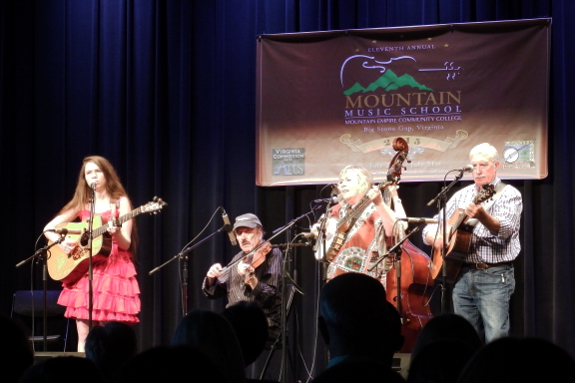
I'm proud to report that
I've so far met my New Year's resolution of taking one work day off per
month in 2015. During the peak of weeding season, we did dodge a bit and
take two Friday afternoons off per month instead of indulging in a full
day all at once, but Mark said that counts. (He's easing me into taking
time off gently.)
Kayla was my partner in
crime during our most recent random holiday, providing moral support and
acting as my dance partner at the square dancing class at Mountain
Empire's Mountain Music School. We learned the (very) basics of both
flatfooting and of the Virginia Reel and are all fired up to take
another dance class soon. Next up: the classical Indian dance of
Bharatha Natyam. Stay tuned!
We got our wood shed past the
half way mark this week.
There's still a lot more
fallen tree material to cut up which has got us to consider building
wood shed number two in the Fall.
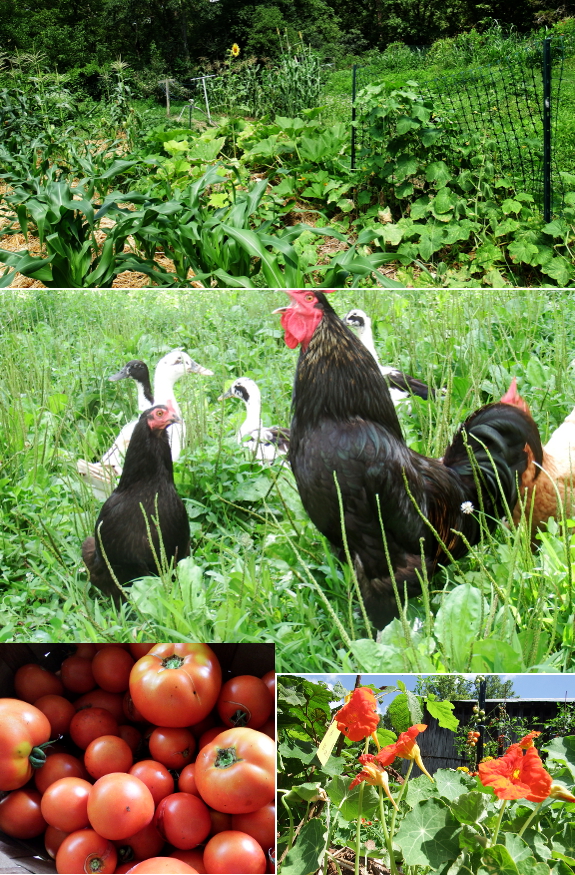
In July, I outlaw all
talk of winter. We don't have enough firewood in, the garden seems like it
will require a time machine to get all of the requisite work done, and
winter stores of all sorts seem inevitably poised to fall short.
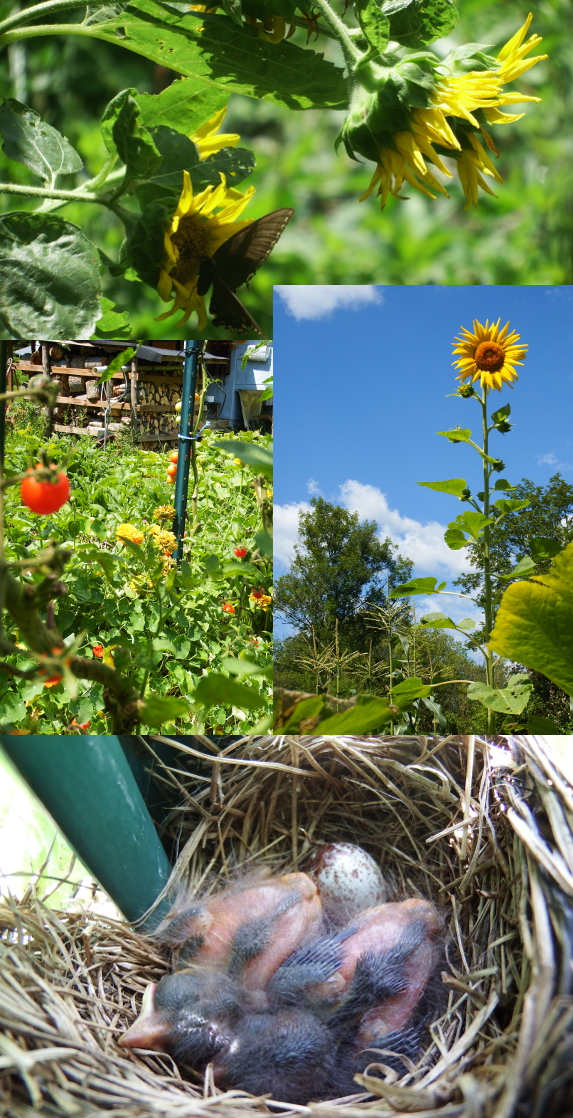
In August, I embrace the
changing seasons. The light is subtly different, a spell of cool nights
is bracing and revitalizing. I freeze a sixth of our winter stores in
one week and our wood shed is a little fuller than last year's. I look forward to the harvest successes and accept the inevitable failures as a simple part of gardening.
What a difference a month can make!
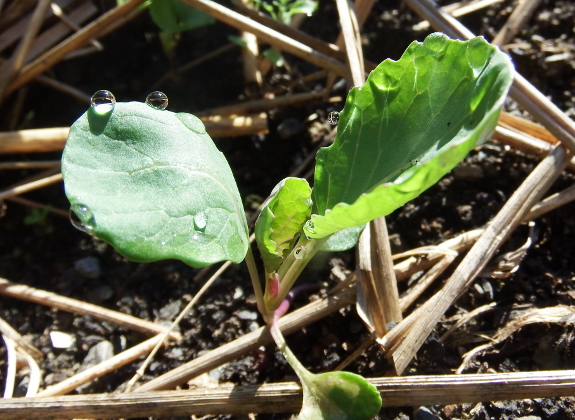
In the middle of the
summer, I'm so engrossed in the garden that I just don't have the mental
energy to research deeply into the solutions to thorny problems. Then,
in the winter, all I can remember is the beauty and deliciousness of our
past successes. So I thought now might be a good time to note some
problematic areas of our current garden for future research.
As basic as it sounds,
I'm still a seed-starting amateur. When I start seeds inside under
low-light conditions (I'm too cheap to use a grow light), they often
succumb to damping off. I put the flats outside in the summer sun and
they dry up in a heartbeat. Next, I try to start those same seeds in a
shady damp bed outside, in which case they get eaten up by (I assume)
slugs. And by the time I finally give up and just start the seeds in my
happy garden soil under heavy irrigation, it's often too late for fall
crucifers to have time to grow before our first hard freeze. As you can
see, our brussels sprouts are a bit smaller than I'd hope for at this
time of year, and our fall broccoli may be nonexistent. Definitely a
topic to research! First stop will be The New Seed-Starter's Handbook.
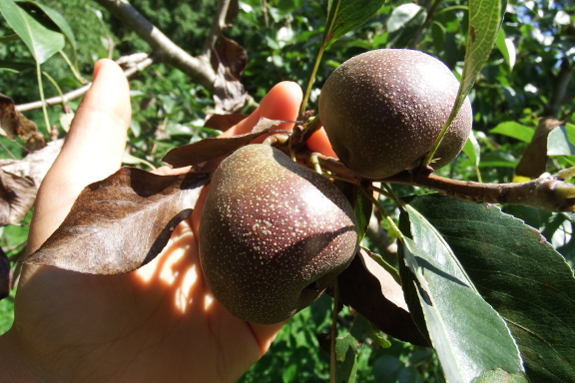
With our tree fruits, I
feel like we're 80% of the way to success...but close only counts in
horse shoes and hand grenades. One obvious issue is the fire blight
on our Seckel pear, but that's probably not worth researching. I
already know that I should have cut out the problematic limbs when they
first started appearing, and I also know that Seckel isn't as disease resistant as other pears we're now trying. Hopefully variety selection will nip this problem in future years.
Late spring freezes are a
more pressing issue since this seems to be the biggest hurdle
preventing us from getting tree fruits at the moment. This winter, I
want to research freeze protection (it really might be worth wrapping
some of our dwarf trees and hardy kiwis) and to start setting out
thermometers at potential orchard areas to gather data on anti-frost
pockets. It's painful to have mature, beautiful trees that simply don't
bear because of one late spring frost, so this topic is near the top of
my research priority list.
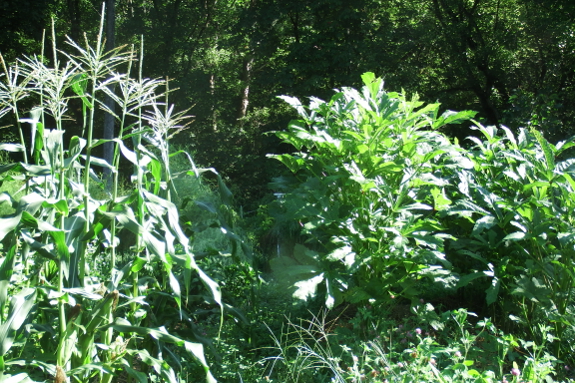
It's not a research
topic, but this year I've been more aware than ever before of how
differently my vegetables perform in full sun (tiny patches of our homestead)
versus partial sun. Our okra, for example, is providing about ten times
as many fruits as in previous years. Why? Because I finally put this
non-essential crop in the center of the sun zone. As our garden soil
gets better and better and we're able to shrink our growing area, I want
to be sure to focus our mulch- and fodder-producing crops in the
partial-sun areas to save the full-sun for vegetables.
What's on your winter research list so your 2016 garden will blow this year's effort out of the water?
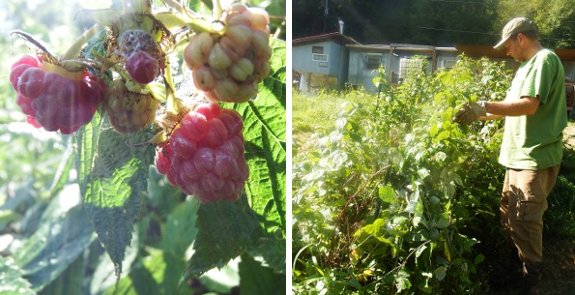
We started eating a second round of delicious Everbearing Raspberries today.
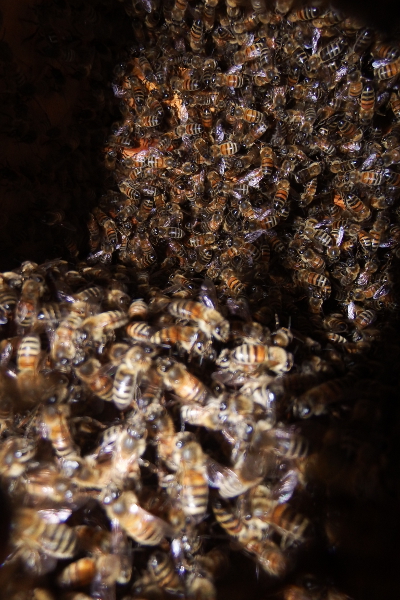 I
hesitated to make this post since I suspect most of you won't get
anything out of it. Chances are pretty good that 40% of you don't need
this information and another 50% of you will poo-poo it. That leaves
only 10% of our readership who might benefit from this post, so feel
free to look at the pretty picture inside our daughter hive and then move on if you're in the 90%.
I
hesitated to make this post since I suspect most of you won't get
anything out of it. Chances are pretty good that 40% of you don't need
this information and another 50% of you will poo-poo it. That leaves
only 10% of our readership who might benefit from this post, so feel
free to look at the pretty picture inside our daughter hive and then move on if you're in the 90%.
Still here? Okay, I wanted to plug a website I've been using for the past month --- happify.
Mark has been training me to use positive thought to boost my
creativity and pleasure in daily life for years now, and this website's
activities are helping me build on that foundation and take my mental
hygiene to the next level.
I've worked my way through the track "Conquer your negative thoughts,"
finding some activities a bit basic but many others insightful and
thought-provoking. This weekend, I started studying the Mindfulness
track and I can tell it's going to continue to help me simplify and
focus my thoughts so they don't look so much like the image above.
In case you're curious, I haven't paid for any of the potential upgrades
they keep throwing at me (the one downside of the website), but I
thoroughly recommend the free version of happify. Just be sure to click
on the little "why it works" links to learn more about the science
behind the projects.
Homesteading is all about
choosing your own adventure, and that adventure can be terrible if your
brain isn't in the right spot. So, go on, happify!
We got 9 bales of hay bought, hauled, and stowed in the Star Plate barn today.
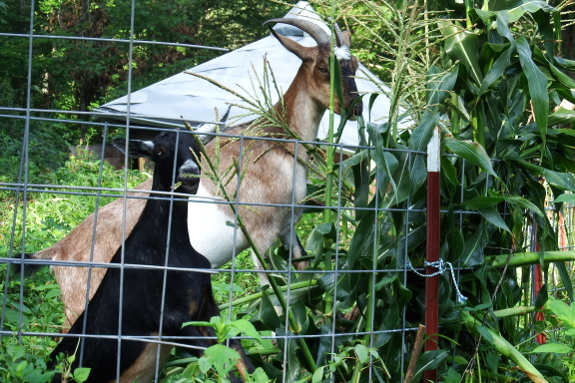
I'll be honest --- this post is really an excuse to share cute pictures of goats.
But there's always
something to say about our darling herd of two. For example, I've
learned that they adore sweet-corn stalks (after we've harvested the
good ears), picking off the leaves and eating the ears that didn't
develop properly. I can smell the sweetness as I cut the spent stalks,
so it's no surprise that our grain-free herd adores the fodder. Our
goats look for sugar wherever they can find it.
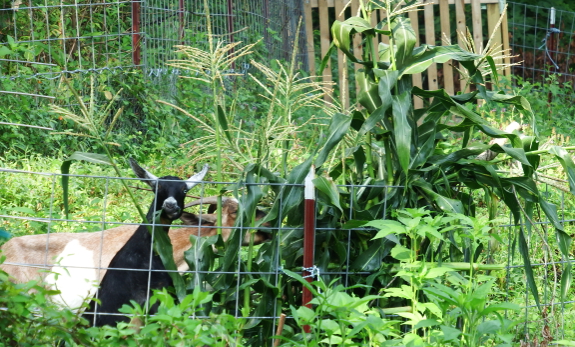
Artemesia is thirteen
months old now, and she's starting to act a bit more like a teenager.
That means she's darling one minute, then the next minute she wanders
off on her own and doesn't obey my request to return to the pasture
after we've finished our evening hour of grazing in the woods. Luckily,
our doeling's sunny personality inevitably comes through in the end, and
those teenage moments are still much rarer than Abigail's more frequent
strong-headedness. (Our older doe is an independent woman.)
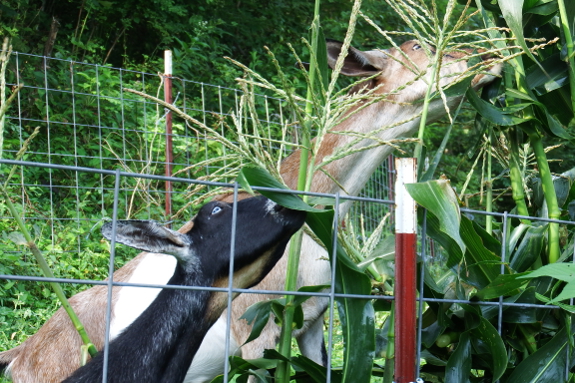
In other goat news, I'm solarizing weedy areas and prepping as much fallow garden ground as I can this month to really boost our fall oat cover crop. Our goats adore grazing on oats after summer weeds are only a memory,
and I suspect that with careful management we could cut our hay needs
in half using the cover crop. We're still in the early days of
goatkeeping, though, so I keep my goals simpler --- plant what I can,
and don't worry too much if I have to buy feed to fill in the gaps.
These new concrete deck blocks will be used for the new wood shed.

In a shocking display of
preemptive selfishness, I planned our August random holiday for only
five days into the month. Kayla had found out about a workshop teaching a
classical dance from the southern part of India, and she was kind
enough to let me come along while she checked it out.

Bharatha Natyam looked so
easy when I watched a youtube video before the class, a bit like a
walking version of yoga. Boy was I wrong! Kayla and I were surrounded by
a passel of young dancers who had been studying ballet for years, and
they had no trouble picking up the steps. But figuring out how to move
my feet and my arms and my hands all in sync was vastly beyond my skill
level, especially once the teacher went at full speed. The dance was
definitely beautiful and fun though!

What I liked most about
the class was the realization that the scenes I'd studied in art history
class of Indian gods in strange poses involved catching those beings
mid-dance. The teacher also opened the class with a simple earth
blessing that I want to learn to incorporate into my own
cobbled-together spiritual practices...but that will only happen if I
can find a video to walk me through the motions on the internet.
Drinking from the fire hose, I'm afraid none of the instruction actually
stuck to my gut.
Despite my inability to recall the most basic steps, it was still so
much fun to go outside my comfort zone and explore new things. I'm
looking forward to seeing what Kayla comes up with for us to try next!
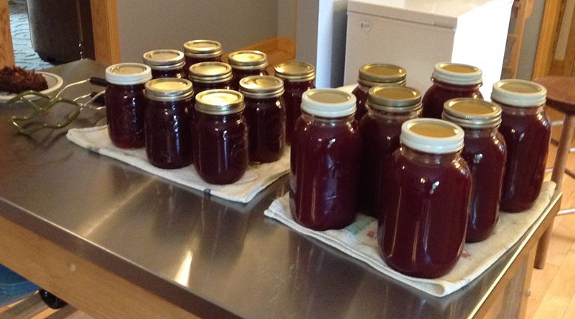
On a weekend near the 4th of
July we, my parents, two younger sisters and I would pile into the
family's 1948 Chevy and drive out in the county to a farm near Shultz,
where my mother's classmate, Feeny, lived. The road into his house
went up a creekbed bordered by a hill on the right and a grown-up
pasture on the left, where a few cows grazed around blackberry
bushes. We 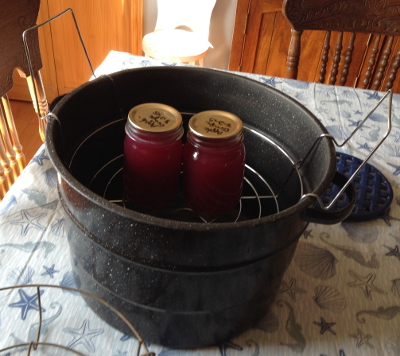 pulled
out of the trunk a washtub, five-gallon pail, and several picking
buckets made by cutting the tops from grapefruit juice cans and punching
two opposing holes to attach a wire bale.
pulled
out of the trunk a washtub, five-gallon pail, and several picking
buckets made by cutting the tops from grapefruit juice cans and punching
two opposing holes to attach a wire bale.
We'd get there early, before
the heat of the day. With the picking-can bale fastened to my belt
I would wander around avoiding others picking blackberries until my can
was in danger of spilling. Then I would take it to where Dad had
left the pail and empty it. When it was full, Dad would empty the
pail into the washtub. Before noon we'd leave with a trunkful of
washtub, pail and picking buckets all filled to the brim with berries.
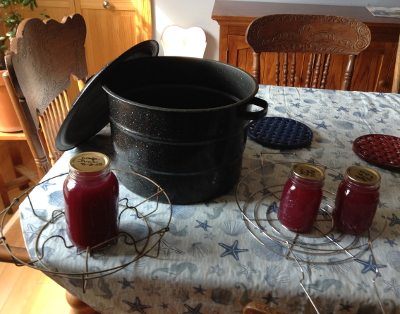 That
afternoon I'd help Mother sort out clean berries from a water-filled
tub, pulling any stems, removing floating leaves and debris. When a
container was full of clean berries Mother would fill quart jars, seal
them with zinc lids and a rubber gasket, add sweetened liquid, and place
seven at a time into a water-bath canner. When they were finished
she removed the jars, tightening the lids firmly and setting them aside
to cool while she prepared another container full. Meanwhile I was
sorting clean berries.
That
afternoon I'd help Mother sort out clean berries from a water-filled
tub, pulling any stems, removing floating leaves and debris. When a
container was full of clean berries Mother would fill quart jars, seal
them with zinc lids and a rubber gasket, add sweetened liquid, and place
seven at a time into a water-bath canner. When they were finished
she removed the jars, tightening the lids firmly and setting them aside
to cool while she prepared another container full. Meanwhile I was
sorting clean berries.
We had enough from that day's work to eat a berry pie every Sunday till the next summer.
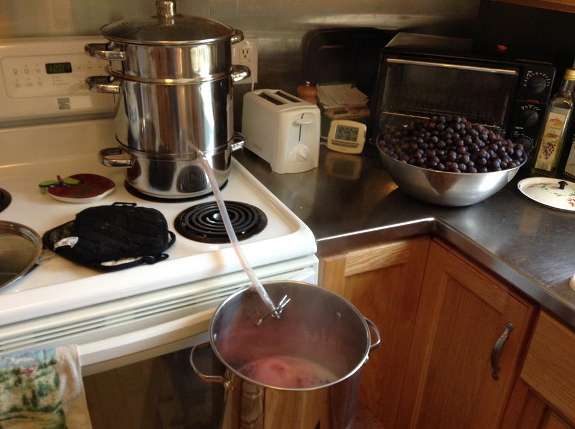
I still use a water-bath canner to preserve fruit, including grape juice and tomatoes.
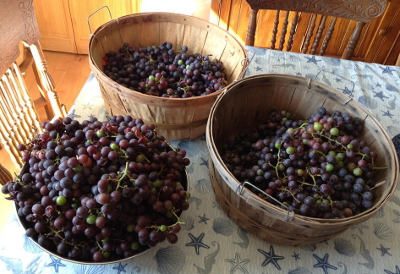 The
tomatoes are cleaned, skinned after a parboil, and packed in their own
juice made by shaking each full jar till it has liquid to an inch from
the top. Tomato juice is easier to prepare using a Champion
juicer. But we learned the hard way that the juicer grinds up
grape seeds, giving the juice a bitter taste. So we use a steam
juicer (pictured above) for our grapes, pears, and apples.
The
tomatoes are cleaned, skinned after a parboil, and packed in their own
juice made by shaking each full jar till it has liquid to an inch from
the top. Tomato juice is easier to prepare using a Champion
juicer. But we learned the hard way that the juicer grinds up
grape seeds, giving the juice a bitter taste. So we use a steam
juicer (pictured above) for our grapes, pears, and apples.
Of course, to can non-acid
foods one needs a pressure canner. Although I grew up eating corn
and beans canned in a water-bath canner, the experts no longer advise
it. Today, I think, most just freeze these vegetables.
Errol Hess is the author of Hunting Pennies, a memoir in verse about his Appalachian childhood.

After dancing, Kayla and I headed over to Heartwood
to peruse some Appalachian crafts (and to eat some lunch). But we got
sidetracked on the way by a sign bound to tug any homesteader astray:
"Plant sale."
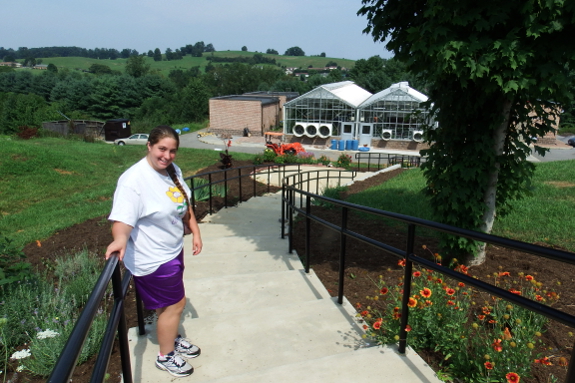
The Virginia Highlands
Community College has a large greenhouse system, and they were taking
advantage of visitors attending the Virginia Highlands Festival
to show off their space (and to move a few plants to new homes). At 25
to 50 cents per plant, I splurged on about a dozen broccoli and brussels
sprouts to add a bit of security to my own tardy plantings, and Kayla
picked out some fall greens and flowers.
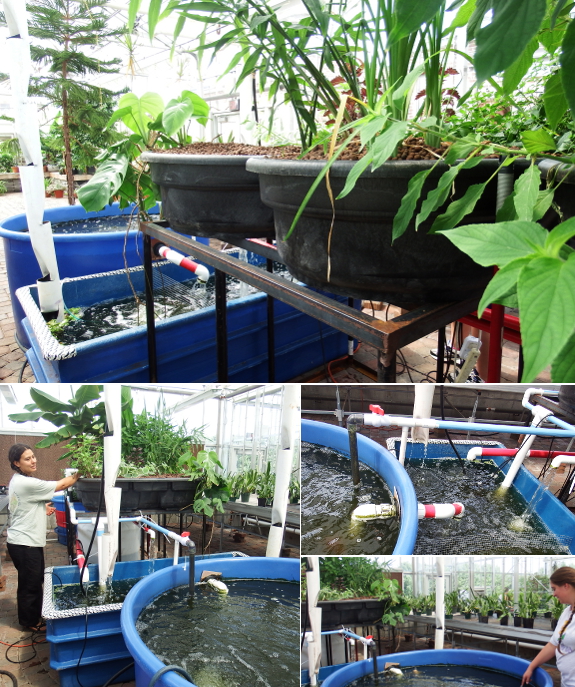
But the most intriguing feature of the greenhouse wasn't for sale. Instead, a large aquaponics
setup was filled with huge koi living happily in water filtered through
the growing medium beneath a slew of plants. Granted, both fish and
greenery were purely ornamental, but it was still intriguing to finally
see an aquaponics system in action.
And that --- plus some
chocolate --- filled up our girl's day out to the brim. Kayla called it a
once-in-a-lifetime experience. Do you think that means she's never
getting in the car with me again?
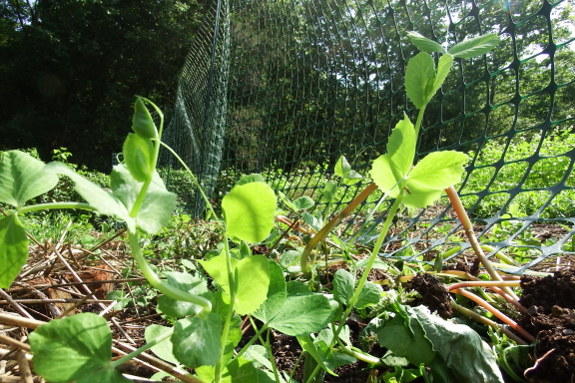
We plant some of our fall crops
in June (brussels sprouts, cabbage, broccoli) and July (carrots, peas).
But August is really the make-or-break month for our fall garden. This
is when I decide which beds are going to be seeded in oats or oilseed radishes
and taken out of commission for the rest of the year, and which will
instead feed us lettuce and leafy greens all fall and winter, along with
slowly bulking up garlic and potato onion bulbs for next spring.
My August goal is always to have the entire garden planted in something
by the end of the month. That might be lingering summer vegetables
(sometimes with cover crops interplanted for fall), buckwheat to hold
the ground for later plantings, fall cover crops, or the first tender
shoots of autumn vegetables. There's no place for weed patches in our
fall garden!
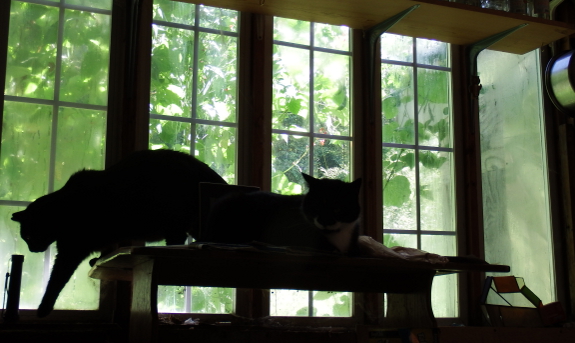
Once the August planting
push is done, the garden slowly begins to calm down. While the landscape
remains vibrant, there's less work after everything's planted and
mulched, and Mark and I start thinking of our fall vacation. We're
planning a staycation
this year, probably in late September or early October. It's nice to
have a carrot to dangle in front of our noses when the sun pounds down
on our heads and the garden threatens to eat us alive (rather than vice
versa). We hope to visit Bristol Caverns, go on a hike, and generally
rest and relax. I can hardly wait!
I installed a quick connect battery tender snap cord on the ATV to make trickle charging more of a daily event instead of whenever we need it.
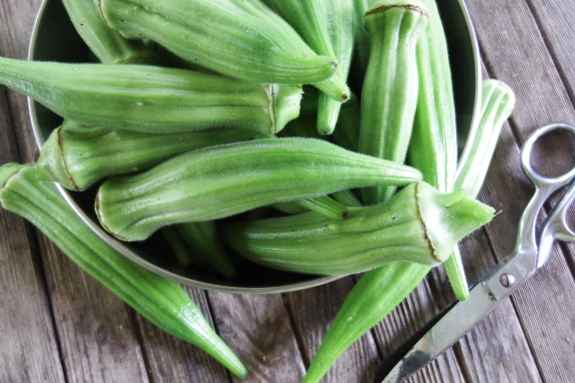
What do you do if you're harvesting two or three gallons of okra per week for a family of two? Freeze some for the winter, then try a new recipe to boost your current consumption, of course.
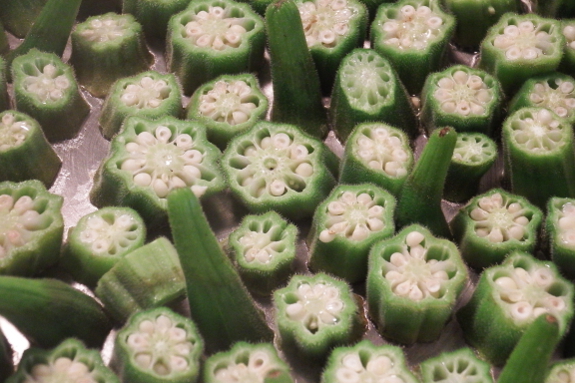
My movie-star neighbor
suggested a technique he calls blackened okra. He recommends starting
with your biggest cast-iron skillet, but I instead opted for an even
bigger stainless-steel skillet so we'd be sure to produce enough to
serve three. I sliced the okra into rounds, placed them one layer deep
on the oiled skillet, then cooked over medium-low heat for about an
hour. I turned up the heat for the last fifteen minutes and stirred
some, but didn't stir earlier since the goal is to drive off moisture
(to prevent sliminess).
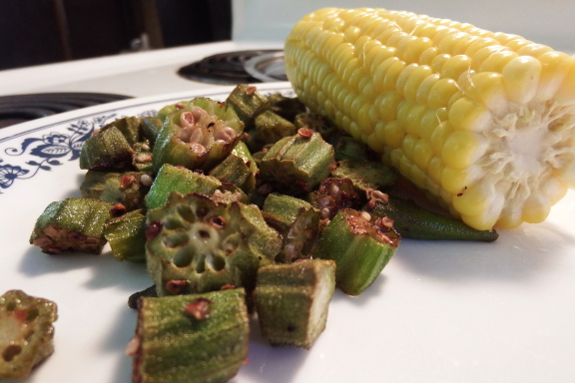
Honestly, I think I could
have cooked the okra a little longer/hotter, because it ended up
browned instead of blackened. It was quite good, though, and half a
gallon was quickly consumed by me, Joey, and Mark, with requests for
more. Definitely a good start on using up all of that okra, but if
you've got an even better recipe I'd love to hear it!
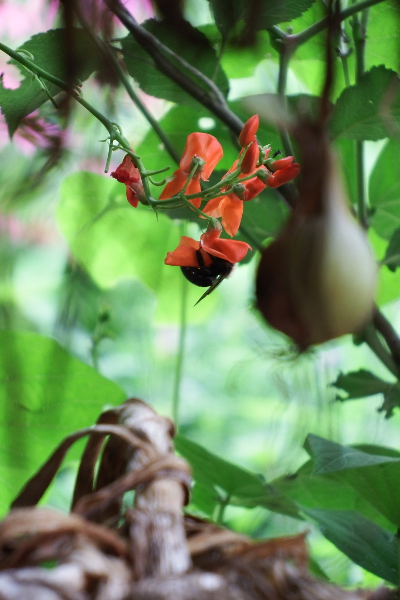
The Scarlet
Runner Beans are probably the most ornamental looking crop we have
in the garden this Summer.
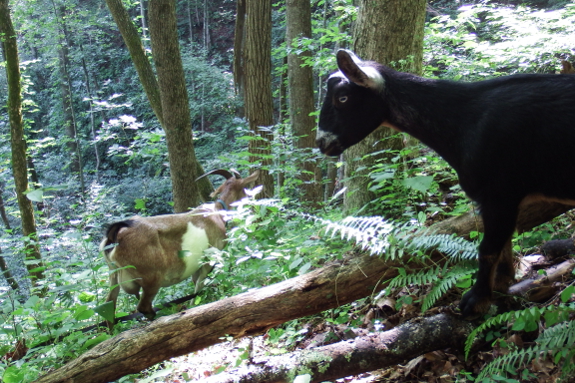
One of my favorite parts
of goatkeeping (combined with our too-small pastures) is that our herd
prompts me to wander in the woods on a regular basis. On previous
summers, I've usually figured I'm too busy to go on extra walks, but our
goats have taught me that there's always time for a good ramble.
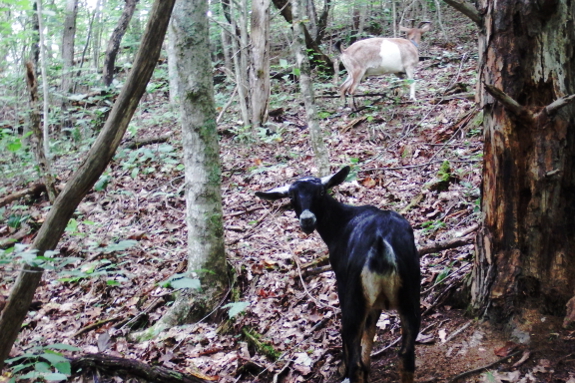
During the week, we just
spend an hour in the evening hanging out within a short distance of the
coop. I read and relax while the goats browse. But on the weekends, I
often like to explore...even if that means we end up in parts of the
woods that are so deer browsed that they're nearly barren from a goat
point of view.
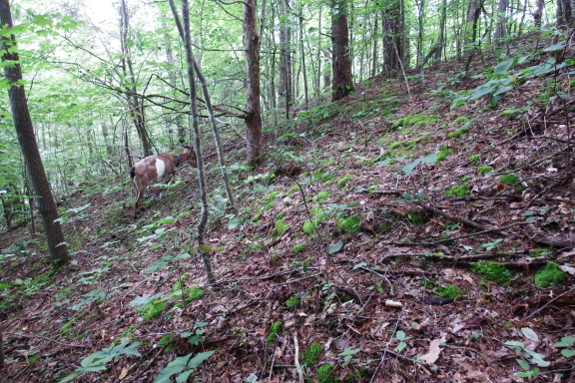
(Note to self --- I
definitely need to buckle down on the hunting this fall. The deer have
been staying out of our garden, but their populations appear to be very
high this year.)
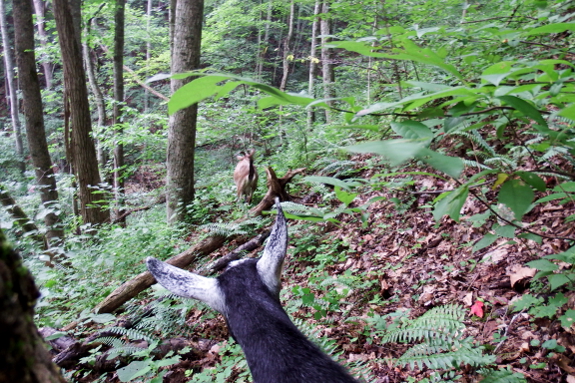
Ah, this spot looks much more goat friendly.
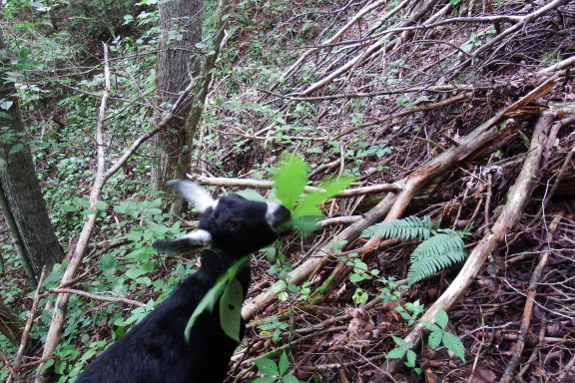
There's nothing like a
pair of goats to make a bipedal human feel even more ungainly than
usual. Our darling does prance across deadfalls like this in a heartbeat
while I slowly pick my way through the trip hazard with much more care.
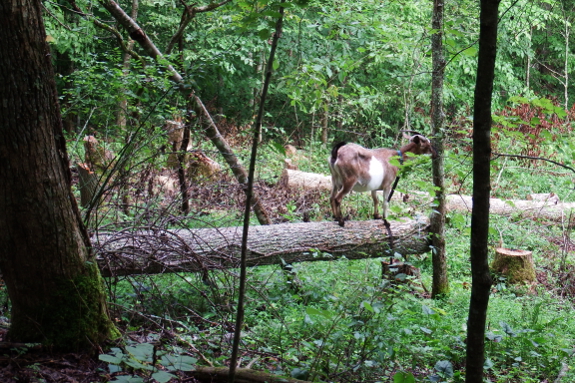
Of course, I shouldn't be
surprised at their agility since the girls have been practicing on
their balance beams for most of the summer. In case you can't tell,
Abigail is repeatedly headbutting that tree in front of her while
staying steady atop the log despite her trailing leash. Ah, to be a
goat.
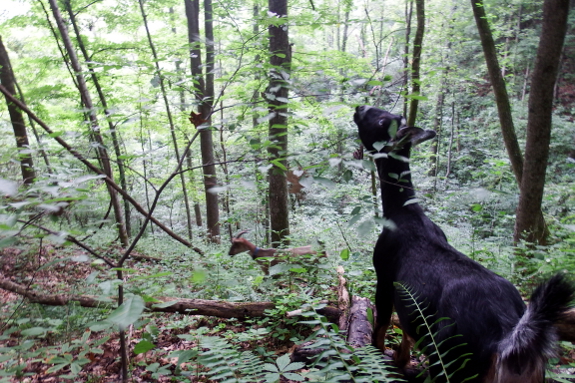
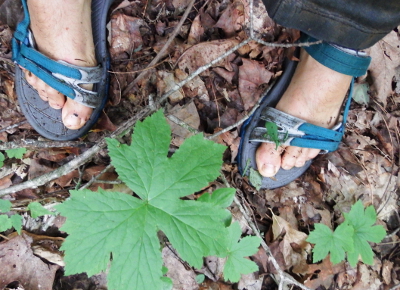 Top
finds of the day Sunday included a small patch of goldenseal that I
likely couldn't pinpoint again and a couple of blooming downy
rattlesnake plantain (a relatively inconspicuous orchid). Plus some extra peace and joy to hoard for the busy week ahead.
Top
finds of the day Sunday included a small patch of goldenseal that I
likely couldn't pinpoint again and a couple of blooming downy
rattlesnake plantain (a relatively inconspicuous orchid). Plus some extra peace and joy to hoard for the busy week ahead.
Thanks for the boost, Abigail and Artemesia!
Three large straw bales seems
to be right at the ATV load limit.
It was dry enough today to get in several trips before the dashboard
started showing a temperature warning light.
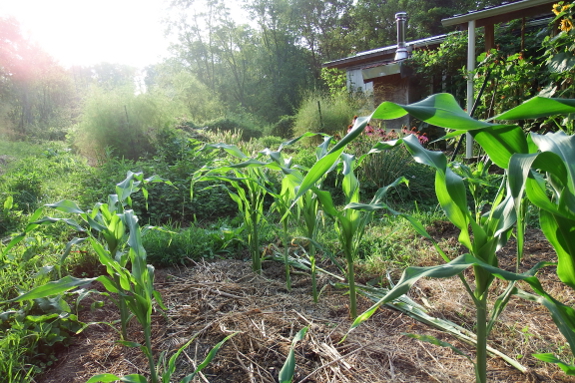
We've eaten our way through 2.5 plantings
of sweet corn, with three plantings left to mature before the frost.
The final beds are right outside our front door, so I walk by them
multiple times a day and watch their growth the way you'd watch sand
slip through an hourglass. The first freeze seems remarkably close when
measured by the height of sweet corn!
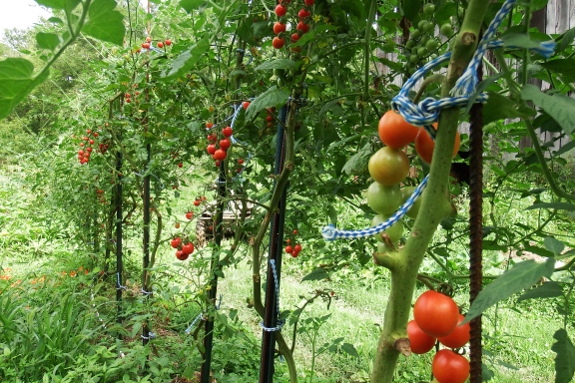
Elsewhere in the garden, I'm also shifting gears with winter in mind. A week ago, my gut said that it was time to stop pruning the tomatoes
because blight had spread so much that I had to remove every leaf if I
wanted to eradicate all signs of the problematic fungi. It turns out
that was a good call --- even with blight (mostly septoria leaf spot)
throughout the plants' foliage, our plants matured more tomatoes than
the previous week due to their extra leaf area. It looks like we'll
reach quota on soup this year after all. Phew!
Our new immersion
hand blender makes mixing basil into soup easy and fun.
What I really like is the
easy clean up compared to a traditional blender.
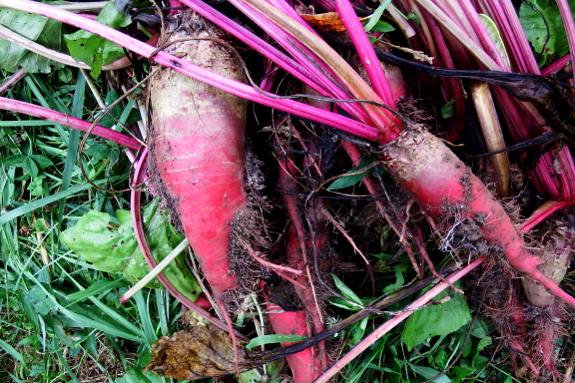
One of our new crops this year is Mammoth mangels,
a kind of fodder beet often grown for livestock. In our case, we're
hopeful the roots will supplement our milk goat's diet during the winter
months. I only planted one bed, though, since I wasn't sure whether
Abigail would actually eat the offering and also wasn't sure how well
the fodder beets would grow in our garden. With new crops, it always
makes sense to start small!
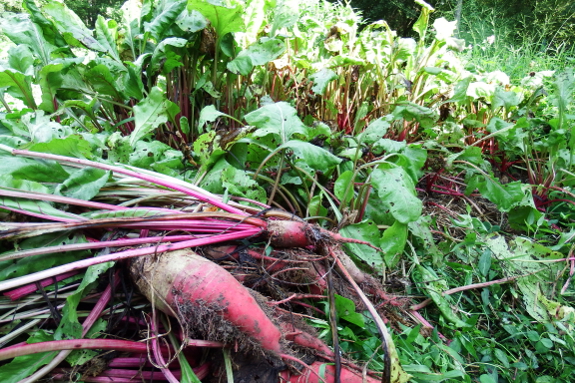
I'd been ignoring our mangel bed all summer, actually. But when I dropped by to weed the bed, I realized that forgetting to thin our plants this spring
meant some roots would be best harvested early. So when I went ahead
and pulled the largest plants and will hope that the smaller mangels
left behind will still have time to bulk up this fall. I ended up with
about half a bushel of thinnings --- pretty impressive from about nine
square feet of growing area!
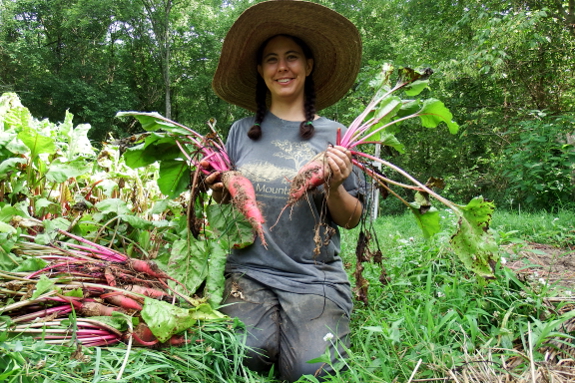
Mangels are reputed to be a high-quality feed for ruminants,
but there are a couple of reasons why the crop has fallen out of favor.
First is the thinning problem. Like their relative Swiss chard, each
mangel "seed" is really a cluster of seeds. So you nearly always end up
with two or three plants in each spot, meaning you absolutely have to
hand thin. As I learned, if your seeds germinate well and you don't
thin, mangels won't thrive since they're too close together. On the
other hand, if you have so-so germination and forget to thin, the plants
can still grow quite large even without thinning.
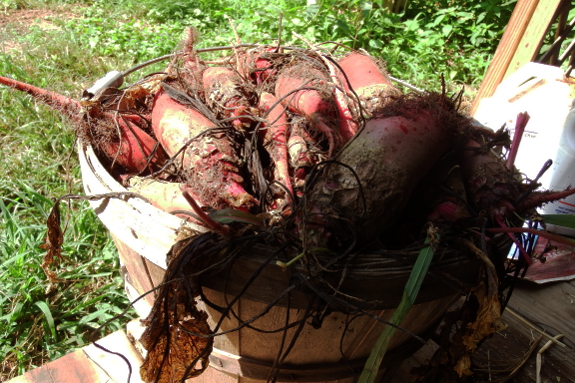
The other potential issue
with mangels is that they can cause scouring (diarrhea) if fed in large
quantities to ruminants. Johnny's (the source of our seeds) reports
that small roots of our variety can be fed to livestock immediately, but
that it's safer to wait at least a month before feeding larger roots.
So I'll try a few of the fingerling mangels on Abigail today and will
sock away the larger roots in the crisper drawer of our fridge, which
has been halfway emptied after the huge influx of carrots this spring
made their way into our goat's mouth. It looks like goat-feed season is
shifting from orange to red roots --- I hope Abigail enjoys the mangels
as much as the more labor-intensive carrots!
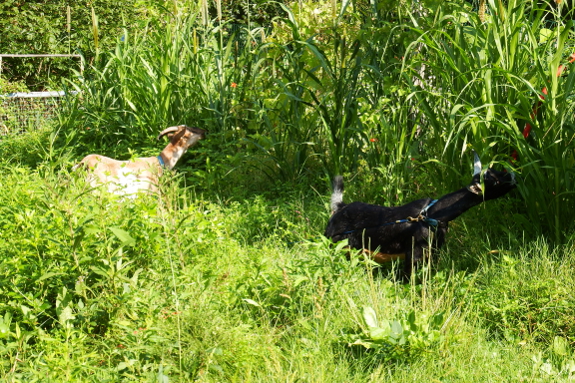
Rule number one of goathood: The grass is always greener
just out of reach. For the record, I took this photo five minutes after
tethering our herd for the day, and there was millet exactly like the
plants Artemesia was straining after within easy reach. Apparently that
bite just beyond her rope looked much tastier, though.
Actually, I debated
letting our girls chow down on the millet leaves (having originally
tethered the herd in that spot thinking they'd go after the tick-trefoil
instead). The trouble is that warm season grasses can produce hydrogen cyanide when stressed by drought or frost,
and our weather has been relatively dry lately. On the other hand, I've
been irrigating that area weekly if there's not sufficient rain, so I
decided to risk a bit of grazing.
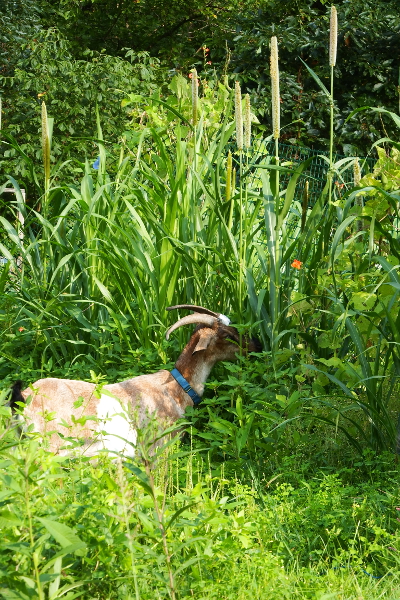 Two
hours after putting the goats back in their pen, though, I went up to
pick blueberries and got concerned when Artemesia didn't meet me at the
gate. I called her name and heard no reply, so quickly put down my bowl
and headed to the coop, terrible images running through my mind.
Two
hours after putting the goats back in their pen, though, I went up to
pick blueberries and got concerned when Artemesia didn't meet me at the
gate. I called her name and heard no reply, so quickly put down my bowl
and headed to the coop, terrible images running through my mind.
Of course, our darling
doeling was simply taking a break, chewing her cud while standing in the
doorway of the starplate coop and gazing out at the world. "Hi!" she
called as soon as I came into view. "I love you!"
(Yes, this is how I parse Artemesia's numerous bleats. Don't tell me what she's really saying --- I don't want to know.)
"No stomach ache?" I asked in response.
"Of course not!" Artemesia replied. "And millet leaves taste even better the second time around!"
For the record, the only weird food that has ever bothered our
iron-tummy goats was when Artemesia drank a whole gallon of mozzarella
whey in one afternoon (whey that Abigail refused to touch). Our
doeling's stomach got a bit bulgy afterwards and her droppings were a
little loose the next day, so now excess whey goes to our dog.
Otherwise, our girls seem to know what is and isn't good for them, and
pearl millet is apparently in the former category.
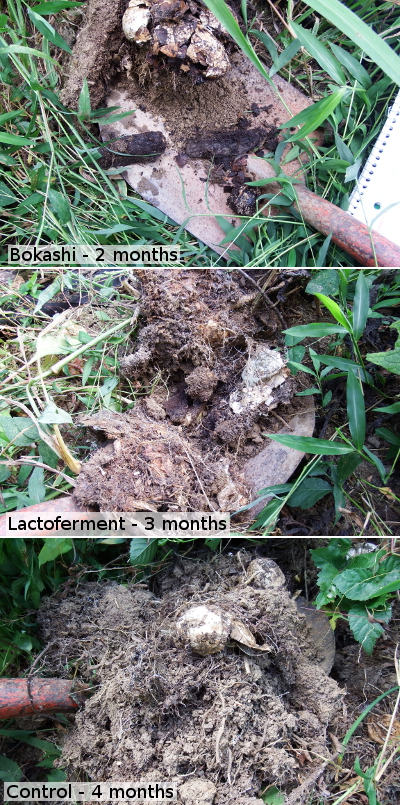 I'm finally ready to pass judgment on this year's bokashi experiment.
To recap, bokashi is a method of pre-decaying food scraps in an
airtight container with the help of a microbial starter before applying
that proto-compost to the soil. I tried three different versions this
spring --- bokashi using a storebought starter, bokashi using a homemade (lactofermented) starter, and a control bucket with no starter.
I'm finally ready to pass judgment on this year's bokashi experiment.
To recap, bokashi is a method of pre-decaying food scraps in an
airtight container with the help of a microbial starter before applying
that proto-compost to the soil. I tried three different versions this
spring --- bokashi using a storebought starter, bokashi using a homemade (lactofermented) starter, and a control bucket with no starter.
It takes us about a month
for us to fill a five-gallon bucket with food scraps during the
non-preserving season. So I had to space my experiments out, applying
the control to poor pasture soil March 17, digging in the lactofermented
scraps on May 8, and the traditional bokashi on June 6. The photos to
the left show that digging up those three patches in the middle of
August resulted in a time-lapse image of decomposition, suggesting that
neither type of bokashi sped up decomposition much, if at all.
Would I recommend bokashi to anyone? Well, the air-tight buckets
were a nice way to consolidate lots of foods scraps, and the bokashi
starter did cut down on bad odors when opening the bucket...although the
starter became much less effective once the true heat of summer hit.
But I don't feel like the method is really worth the expense unless you
live in an air-conditioned apartment and have to hoard your scraps for a
long time before use. Instead, our food scraps have been hitting the
outside compost pile this summer, where I think we'll get just as much
fertility with much less work (and no outlay of cash). It looks like
bokashi isn't for us.
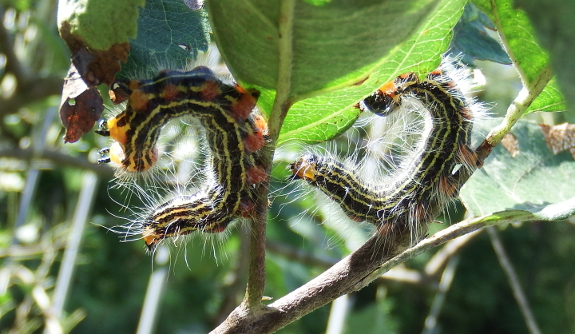
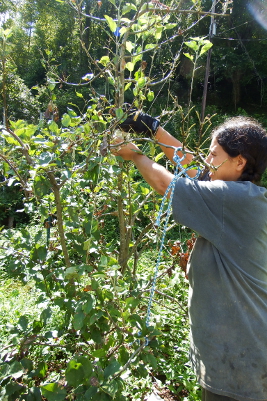 This has been a bad year for caterpillars on fruit trees. First came the fall webworms, who ate through leaves like nobody's business. And this month the yellow-necked caterpillars hit one of my dwarf apple trees.
This has been a bad year for caterpillars on fruit trees. First came the fall webworms, who ate through leaves like nobody's business. And this month the yellow-necked caterpillars hit one of my dwarf apple trees.
I'm not used to worrying about caterpillars other than cabbageworms, actually. We have so many wild predators
--- like wasps and birds --- that most infestations are gone in short
order. But ignoring the issue didn't make it disappear in either case
this year, so I resorted to hand picking.
As you can see in the
photo to the right, I should have picked a little sooner. I only found
about a dozen caterpillars in our apple tree, but they were all big and
fat after eating about a third of the available leaves. Luckily, the
nibblers died quickly when dropped in a jar of plain water --- problem
solved!
We had a small deer incursion last week that seems to have been thwarted thanks to this mechanical deer deterrent and the metallic noises it makes..
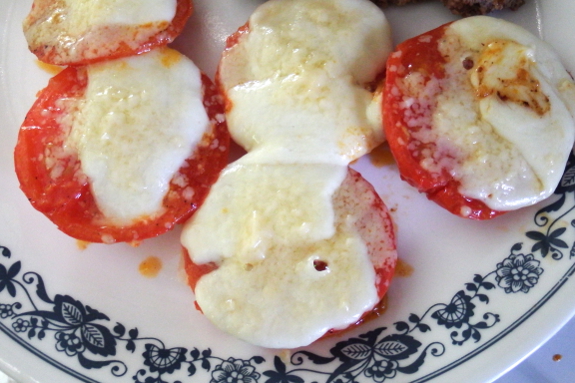
Want a summery side-dish
treat? Pick some firm tomatoes (romas are a good bet, or slicers that
are pink instead of red), slice each one, then cook the slices in a
medium-heat, greased skillet until the bottom begins to turn orange-red
instead of pink-red. Flip your tomatoes over and top each with a thin
slice of homemade mozzarella,
a sprinkle of salt and pepper, and a little grated parmesan. Put on the
lid and cook some more, just until the cheese melts. Delicious!
And now I need to make more mozzarella....
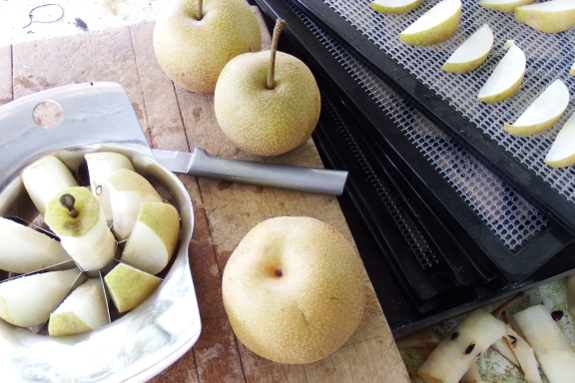
Joey dropped off some pears that
were improved with a little Excalibur
drying.
I broke a few cheap apple slicers before I upgraded to the best
apple cutter.
We've used it a lot over the last 4 years and it will most likely last
another 400.
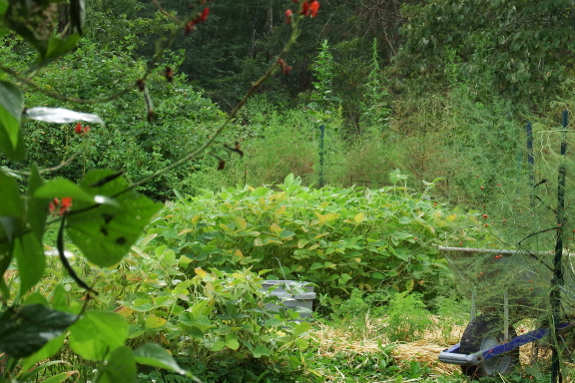
"Is the below (more or less) the formula for planning on when to plant for our Persephone date?
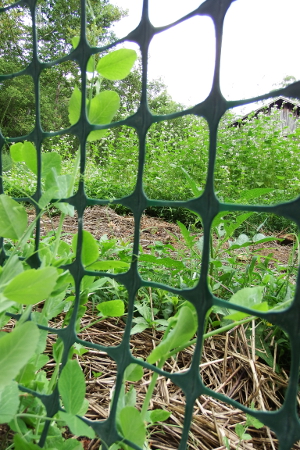 "Or do you just have a chart already made up that you would be willing to let me try?
"Or do you just have a chart already made up that you would be willing to let me try?"My garden space is ready and waiting, and I still have a lot of good seeds."
--- Jeannette, zone 7, east Tennessee on a gentle southeast slope of a mountain
Jeannette, I've been
getting lots of fall-gardening questions lately, so I thought I'd answer
yours in a post instead of via email. Persephone Days
are most relevant for people who garden in a mild climate, in a
greenhouse, or are growing hardy leaf crops like kale and lettuce. The
date tells you when these cut-and-come-again crops will stop producing
due to lack of sunlight, but it doesn't take into account killing
freezes that will completely wipe out your crops. Broccoli, for example,
is going to kick the bucket at 25 degrees Fahrenheit unless you cover
it well, so the Persephone Date (which comes much later than the
hard-freeze date for most of us) is irrelevant.
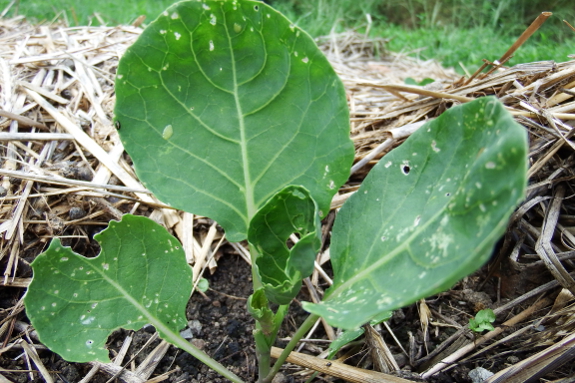
My favorite chart for fall planting is here, and I give you lots more information about how to choose planting dates and how to make easy frost-protection in my book Weekend Homesteader.
The short version is --- it's too late for you to plant carrots,
cabbages, and broccoli from seed, but you can still have a great fall
garden with leafy greens (kale is our special favorite) and lettuce,
which grow much faster than other fall vegetables. If you buy big sets,
you might also get away with planting out brussels sprouts, cabbage, and
broccoli now since you live further south than we do. We don't like
radishes, but I believe they're pretty fast so planting another round of
those as well as some turnips could fill in the gaps. Just be sure to
check the days-to-maturity date on your packets and add two weeks for
safety --- some varieties grow much faster than others!
I hope that helps, and
good luck with your fall garden. I always feel like I get more food for
my effort with the fall garden than at any other time of year, so it's
definitely worth figuring out.
We harvested 38 healthy sized
butternut
squashes today.
There's still a whole lot
more that needs another week or two on the vine.
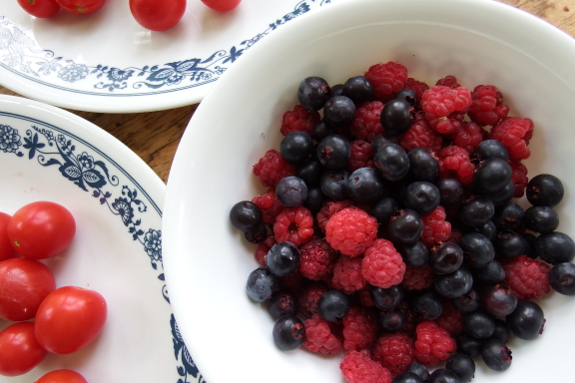
Monday is usually the day
to catch up on pressing issues that caught my eye over the weekend.
This week, that meant harvest, harvest, harvest!
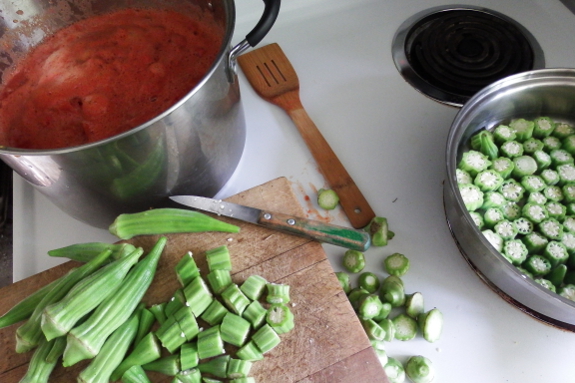
In addition to picking the butternuts Mark posted about yesterday,
I froze just shy of three quarts of tomatoes and basil, picked some
mung and scarlet runner beans, and served us fresh berries and blackened okra
with our lunch. We're now up to 18 gallons of veggies in the freezer,
which is a little less than we'd put away at this time last year but
which is still on track for socking away our winter stores in a timely
manner.
There are few more satisfying times of the year for a gardener than preservation season. Don't forget to enjoy the bounty!
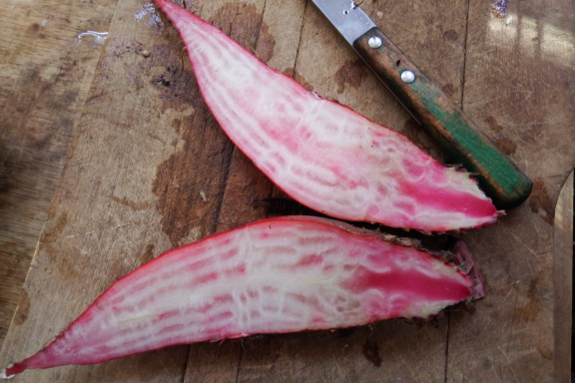
How does Abigail like small mangels that were recently harvested?
She hates them!
We're hoping maybe a month of
curing will make them more delicious.
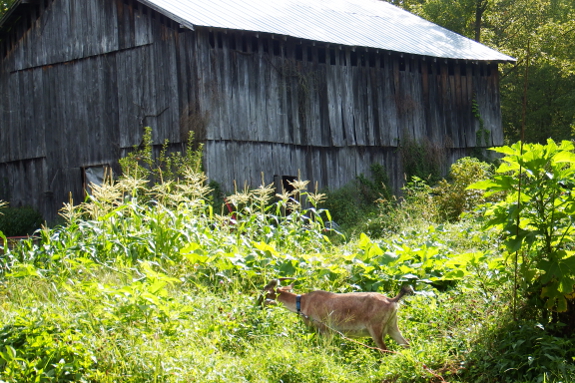
Now's a good time to go
out and look at experimental crops to see if they're worth growing next
year. I started out my exploration by tethering Abigail between our
little patch of Tithonia diversifolia
and a big patch of weeds. Since Tithonia was meant to be a
cover-crop/goat-fodder-crop, I didn't give the cuttings the TLC I
usually offer this spring (although I did plant them in a very damp spot
as instructed). Given my neglect, it's no big surprise that only about a
third of the cuttings took off. The other two plants are much smaller,
but you can see our largest Tithonia on the far right side of the photo
above.
Did you also notice how
Abigail has wandered off in the totally opposite direction? She
preferred ragweed, red clover, and plantain within her tether-circle to
the Tithonia, completely ignoring the latter's leaves after one taste.
So while this cover crop clearly has potential in the tropics, I'm going
to have to say it isn't worth babying as cuttings over the winter in a
temperate climate. (At least not if you have spoiled goats like we do.)
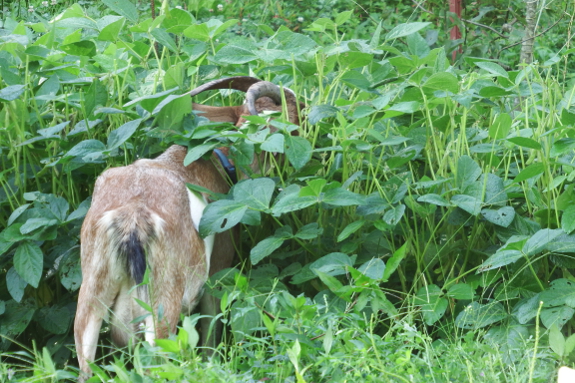
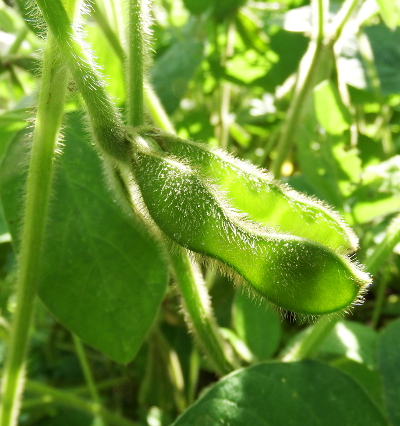 Soybeans, in contrast, have proven themselves to be not only a great cover crop
but also a goat favorite. At first, Abigail picked off all of the
high-protein leaves in the patch she was tethered near. But soon our
smart goat learned that if she delved a little deeper, she could
daintily pluck the half-filled pods off the stems instead.
Soybeans, in contrast, have proven themselves to be not only a great cover crop
but also a goat favorite. At first, Abigail picked off all of the
high-protein leaves in the patch she was tethered near. But soon our
smart goat learned that if she delved a little deeper, she could
daintily pluck the half-filled pods off the stems instead.
While you're supposed to cook dried soybeans in some way before feeding them to animals (or people) due to phytates,
our doe seems to love the raw-soybean treat at the endamame stage. I'd
be curious to hear from someone more knowledgable than me. Do you think
phytates in young soybeans are problematic, or are these more like green
beans and snap peas --- pretty harmless and delicious when young?
Artemesia prefers to bend down stalks of Rag Weed so she can reach the top where the leaves are new and tender.
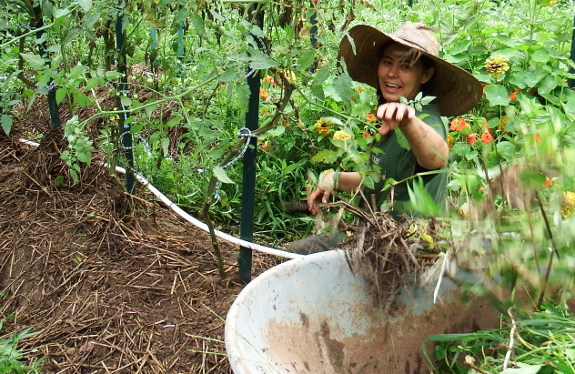
From a biological perspective, I prefer a patchwork-quilt garden.
I don't like actual companion planting because I feel like the
companions always compete with each other. But a bed of one vegetable
surrounded by a bed of four other types of vegetables tends to break
pest and disease cycles and also promote pollination (especially if you
slip in a buckwheat or flower bed here and there).
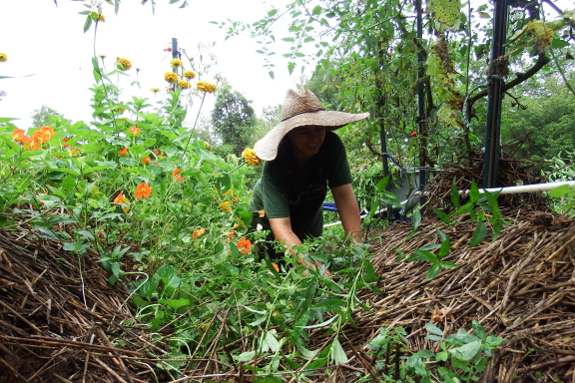
On the other hand, there are issues with the patchwork-quilt approach. Watering can be tricky if you use overhead irrigation, so I already pull my tomatoes out to live in their own dry patch with drip irrigation. Major runners like winter squash and sweet potatoes often fare better if given a compound rather than a single bed since you can let the vines intermingle rather than begging them to stay on their own side of the garden. And I've learned the hard way that it's very difficult to graze goats on an oat cover crop if that grain is next door to overwinterers like garlic and kale that you don't want nibbled.
So I'm setting aside
entire zones of the garden for goat grazing this winter...which means
weeding under the current plants and scattering oat seeds this month.
I've had good luck with this technique in the past amid tall summer
crops like tomatoes and corn, so am pretty confident I can turn the
entire forest and back gardens into goat-forage zones. But there are
only two weeks left to plant if I want the oats to have time to grow
before winter cold sets in. So for the rest of August, oats are a top
priority!
We're still harvesting large bowls of Masai beans on a semi-regular basis.
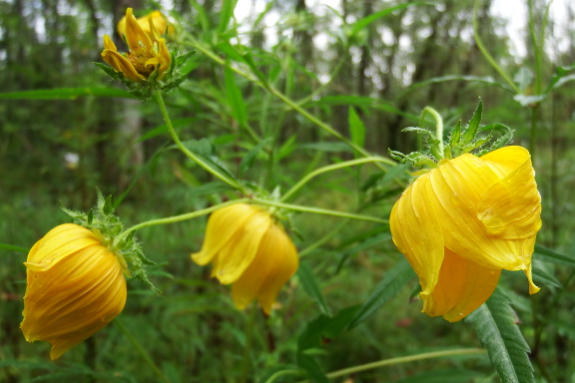
The fall rains have come.

1.6 inches over the
course of a week is close to average around here. But we'd enjoyed a
couple of dry months this summer, so the returning water feels like both
a relief and a surprise.
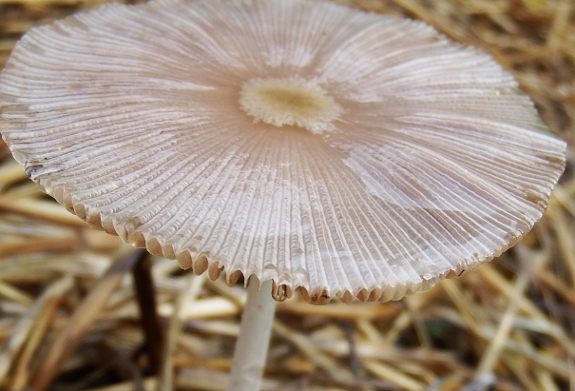
Of course, given how wet
it was last winter, our soil never really dried six inches below the
surface. But as a gardener starting fall crops, it's the surface that
counts.
So hauling gets pushed back into the maybe-it'll-dry-again future and
planting takes a front seat. Time to cover the compost piles so those
nutrients don't leach away!
I had to repair the milking
stanchion again today.
Our girls can be rough when
they want to be. The damage usually happens when they fight each other
for what treats are left after milking.
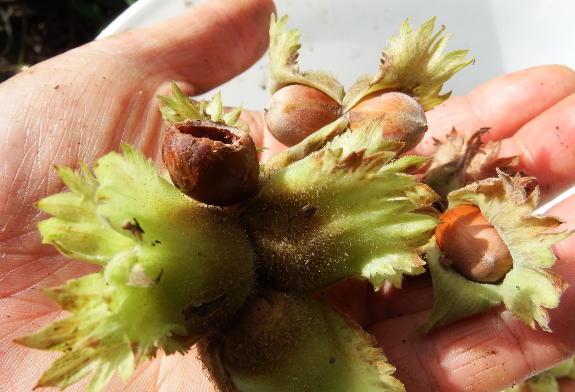
Last year, our hazelnuts weren't ready to pick until early September.
But when I was weeding around the bush on Friday, I noticed a few
clusters had fallen to the ground, and several of those nuts were gnawed
open on one end. That's a classic dining pattern for flying squirrels, so I figured I'd better bring in any nuts that were ready ASAP!
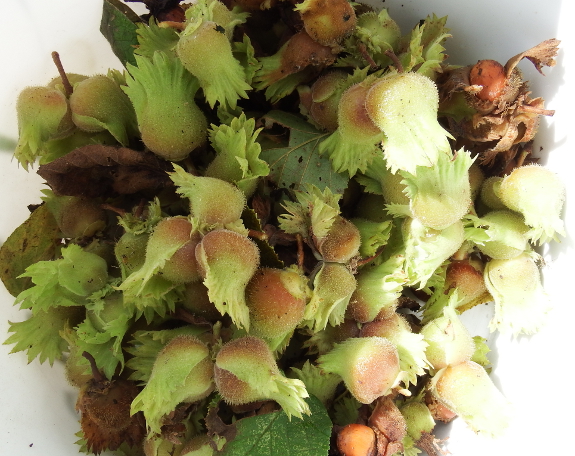
Our hazelnut bush is now
six years old, and this is our first significant harvest. After a little
handpicking, I realized that the easiest method was to clear away the
few weeds that had grown up through the cardboard beneath the bush, then
to shake each limb vigorously. About half of the nuts dropped and were
easy to pluck off the ground. I'll go back next week to try to beat the
squirrels to the remaining clusters.
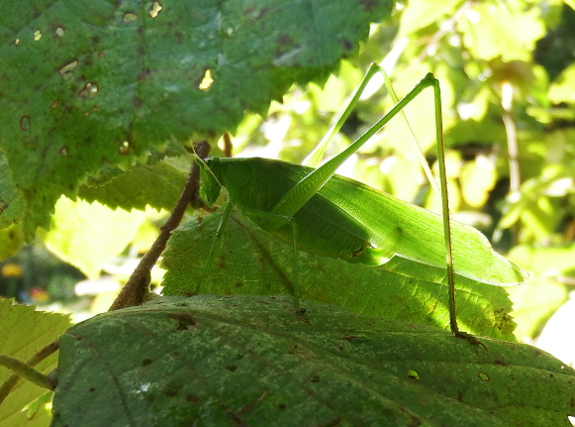
(Look who joined me in my harvest morning --- a beautiful katydid!)
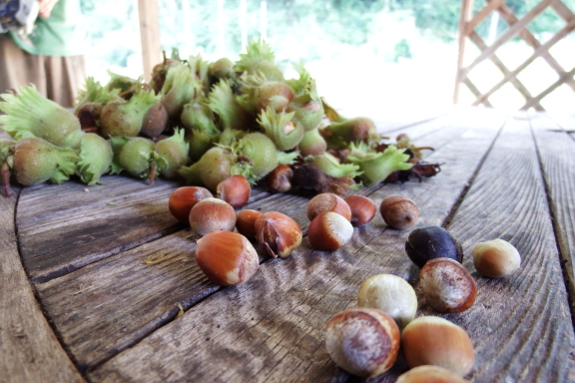
Back at the trailer, I
decided to dehull the nuts right away. Really, I would have been better
off waiting for the hulls to dry since some required prying action to
get the leafy lobes apart. But it's been so wet that I was afraid the
nuts would mold in their shells, so I went ahead and dehulled, ending up
with about a cup of hazels in the shell for this first batch. Not a
whole lot, but pretty exciting since we only got five hazelnuts total
last year!
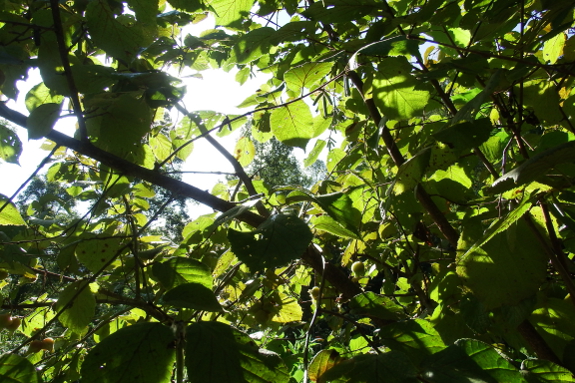
Meanwhile, back in the
garden, our bush has already created proto-flowers to produce next
year's nuts, as you can see if you look closely at the photo above.
Except for the multi-year wait for the first harvest and the possible
squirrel problem, hybrid hazels seem to be an excellent low-work food plant. I'm glad we set out three extra bushes last fall!
The glue
repair I did on Anna's sandals only lasted a few months.
I talked her into buying a
replacement pair, but the new design had a problem staying fastened.
So far two zip ties locking
down the front strap seems to be the solution.
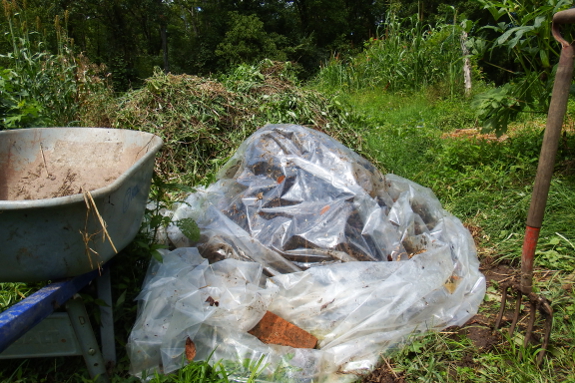
One of my favorite things about having a traditional compost pile this year is that it makes it simple to use up all that high-nitrogen urine
that often goes to waste on our farm. I figure about half our pee has
made it onto the piles this summer, which has probably pushed the
compost a little on the higher nitrogen side than was optimal.
How can I tell? When I forked through one pile to consolidate it with another, I found lots of black soldier fly larvae.
These grubs usually show up in compost that's not quite optimally
balanced, and they mean I probably should have added some extra ragweed
or other carbon source to even things out.
On the plus side, the pee
has made our compost piles decompose fast. Our two oldest piles, now
merged into one, are in their final cooking stage, covered by plastic to
keep excess rain at bay. I figure the summer's weeds (and pee) will
result in maybe two to three wheelbarrows full of compost when all's
said and done, or approximately 5% of the vegetable garden's needs for
the year. Yes, it's a drop in the bucket, but a satisfying one!
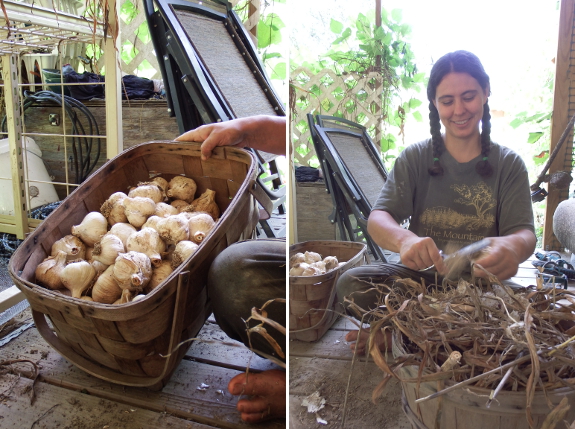
We've been getting our garlic ready
for Winter storage.
I can't remember the last
time we bought garlic at the store.
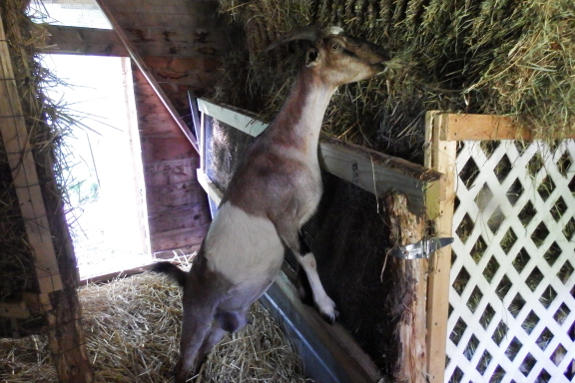
The world is green, the grass is lush...and now's the time to stock up on hay for the winter. But how much will we need?
You'd think that my relentless recordkeeping would have the answer to
that question since we've already enjoyed one winter with goats. But we
bought hay a bit at a time last year, and I have just a vague memory of
using two bales per week for our herd of two during the peak of winter's
cold. That was before we lowered our hay-wastage with a better manger,
and I don't have solid estimates on hay usage during the shoulder
seasons, though. So I'm not really sure how many bales we went through
in the end and how that will relate to years to come.
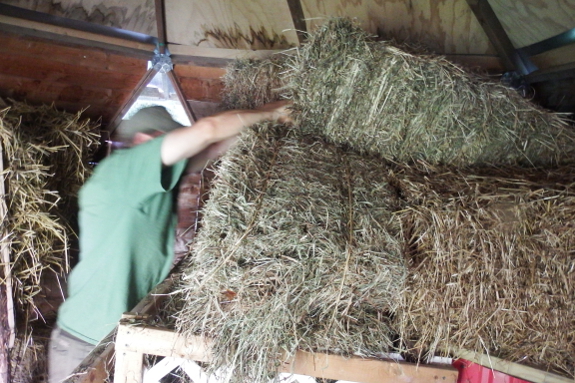
Luckily, the internet is
always willing to come to the rescue. Various websites suggest that a
full-size goat will eat about 5 pounds of hay
per day and a dwarf will eat about 3 pounds per day. Since our goats are
semi-dwarfs and I figure we have to feed them hay for about 6 months
out of the year, I'm guessing we might need about 29 bales (roughly 50
pounds apiece, $6.50 per bale from the feed store).
On the other hand, good
hay is much easier to find at this time of year than if you run out in
March, so I'd really like to have more like 40 bales on hand for
safety's sake. We've learned that our kidding stall holds 27 bales...but
that the girls like to nibble down the edges (far more fun than eating
out of the manger), bringing the actual stored total closer to 25 bales.
Time to find a dry, accessible place to store another 15 bales of hay!
We had some more deer damage
that's starting to threaten our Fall garden.
I dug out the trail
camera, didn't have batteries but noticed an external power hole,
found a universal plug, selected the proper voltage and turned it on.
The screen powered up, but then went blank with a slight burning smell.
I'm pretty sure I got the polarity wrong on the plug and burned it
out.....Ouch.....
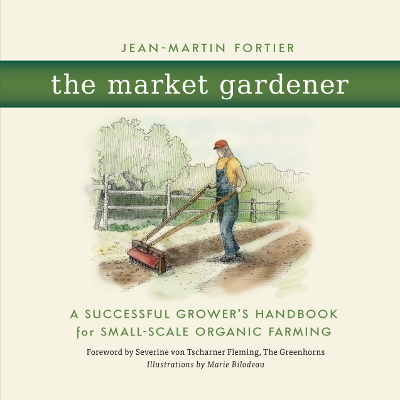 I kept hearing good things about The Market Gardener
by Jean-Martin Fortier, but I put off picking the book up because I
have no inclination to sell any of our homegrown food. Having now
consumed this easy-to-read and gorgeously illustrated text, I now
recommend it to just about every reader on this blog. If you're
interested in producing food for a CSA or farmer's market, the book is a
no-brainer. But it's also invaluable for intermediate-level home
gardeners who want to streamline their production by focusing on
techniques that really work.
I kept hearing good things about The Market Gardener
by Jean-Martin Fortier, but I put off picking the book up because I
have no inclination to sell any of our homegrown food. Having now
consumed this easy-to-read and gorgeously illustrated text, I now
recommend it to just about every reader on this blog. If you're
interested in producing food for a CSA or farmer's market, the book is a
no-brainer. But it's also invaluable for intermediate-level home
gardeners who want to streamline their production by focusing on
techniques that really work.
Fortier's thesis is
simple --- those of us gardening or farming on less than two acres need
to minimize our startup costs, to focus on hand tools and light power
tools, and to plan for high productivity in a small space using
intensive methodology and season extension. He explains that you can
expect to net between $30,000 and $50,000 per acre per year by working
(long hours) for ten months selling directly to the public. His CSA,
located in zone 5 of Quebec, for example, feeds 200 customers off 1.5
acres and pays his family's bills while also employing 3.5 workers in
the process.
I won't go deeper into
Fortier's methodology because the book is such a delight to read with
its extensive drawings and short, punchy chapters that you're really
better off going straight to the source. However, you probably will hear more about caterpillar tunnels here in later posts since The Market Gardener explained just the method I think I've been looking for to protect crops a bit more than quick hoops
do, but without the permanence and expense of high tunnels or a
greenhouse. So stay tuned to follow along with our experimentation in
that direction this fall!
I started a Film and Video class at ETSU today and will not be making a blog post on Tuesdays and Thursdays till December.
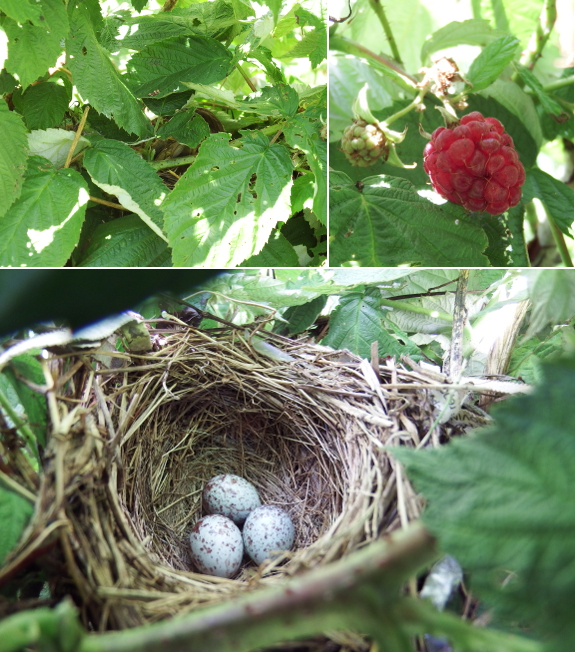
It's not as if I go
hunting song sparrow nests throughout our yard. But I seem to have found
each of our resident pair's nurseries this year.
The newest eggs are secreted away amid the raspberry canes, which I think will be a safer location than round two in the tomatoes.
Because I'm pretty sure that my tomato-leaf pruning opened up the
former nest too much and allowed a cowbird to lay one or more parasite
eggs, which is probably one I found a chick pushed out of the nest and
another disappeared days later.
Here's hoping three's the charm for our sparrows and Mama Bird will have a more successful hatch this time around.
We picked up our new Fall
chicks today.
The Post Office always calls
us as soon as they arrive off the truck.
Lucy never gets tired of
smelling a new poop filled box.
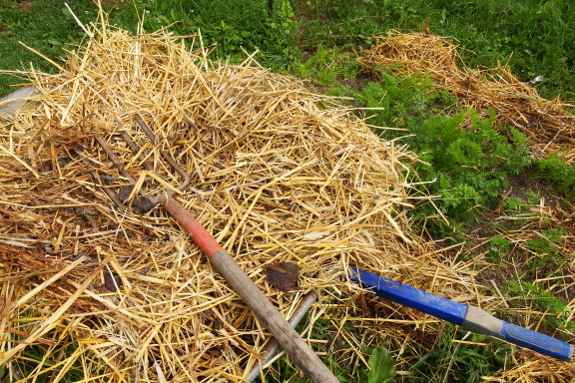
This year, our garden has
subsisted on 95% homegrown manure. This was more of an access issue
than a planned experiment, so I ended up behind and unable to compost
the bedding before application. I needed that fertility now rather than later.
As you might expect, my
results have been affected by that shortcut --- I figure we're at about
75% productivity compared to previous years when I fed the garden well-composted horse manure.
But we're finally caught up, so winter bedding will be composted and
hopefully next year we'll be back up to speed. And, just think,
homegrown manure means 70% less hauling work, 80% fewer weed invasions,
and 100% more control --- a definite long-term plus for our farm!
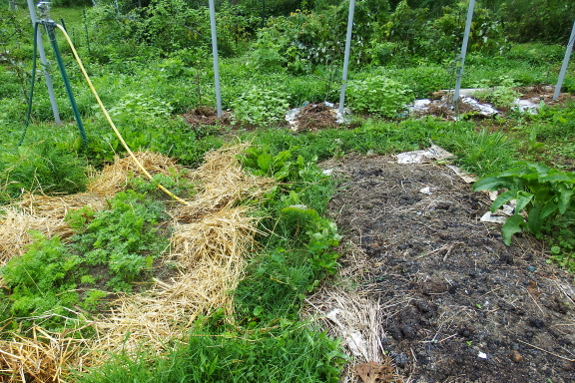
Interestingly, there have
been some areas in which the uncomposted goat bedding trumped
well-composted horse manure. My plan over the summer has been to apply
the goat bedding two weeks to one month before planting to ensure there
wouldn't be any seedling burn from fresh urine and goat berries. Then,
if I was planting something large (like sweet corn), I raked back the
manurey straw when I was ready to make planting furrows. If I was
planting something smaller like carrots, I raked all of the bedding to
the side of the bed, to be pulled back up around seedlings once they
sprouted.
The photo above shows two
beds planted with carrots on the same day. The bed on the right was
topdressed with the last of my stockpiled, well-rotted horse manure. The
bed on the left was treated as explained in the last paragraph with
goat bedding. I had almost zero germination in the horse manure bed,
which has been a common problem in previous years when getting the fall
garden going --- small seeds fail to sprout during dry spells, despite
what seems to be sufficient irrigation. So perhaps putting horse-manure
compost on the surface was the issue all along. I assume the compost
sucked up water and made the beds drier on the surface since the bed
next door sprouted quite well. In contrast, goat manure on top of the
soil kept the ground moist until planting day, then didn't get in the
way of seedling germination since I raked the straw to one side.
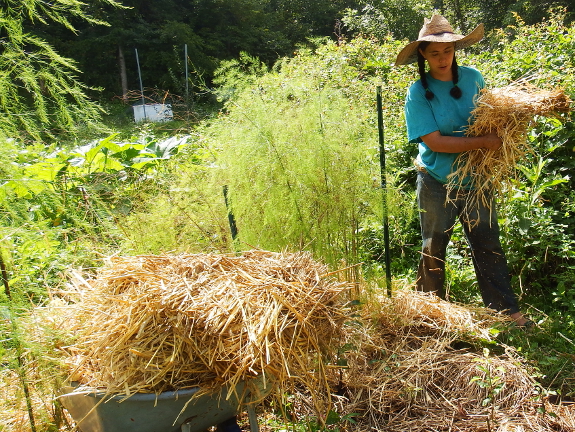
For new annuals, it's
pretty easy to incorporate a waiting step between bedding application
and plant growth. But what about when fertilizing perennials who are
already in place? I was a bit leery when topdressing fresh goat bedding around our strawberries and asparagus, but I ended up seeing fewer issues than expected. The strawberries, actually had no
complaints, presumably since there was already a layer of straw beneath
the goat bedding to sop up any high-nitrogen effluent that floated down
toward the ground. The asparagus was a bit less pleased, with the
youngest fronts showing wilting of the top four inches or so, a clear
sign of nitrogen burn.
Since my test asparagus
beds showed issues with the straight goat bedding, I'm now trying out
plan B on my other asparagus planting. I laid down a section of
newspaper (for weed control), then a healthy layer of fresh straw (to
buffer the nitrogen), then Mark and I scattered chicken manure from the
spring brooder lightly over top. Hopefully the nitrogen will be more
asparagus-friendly by the time it reaches the asparagus root zone this
time around.
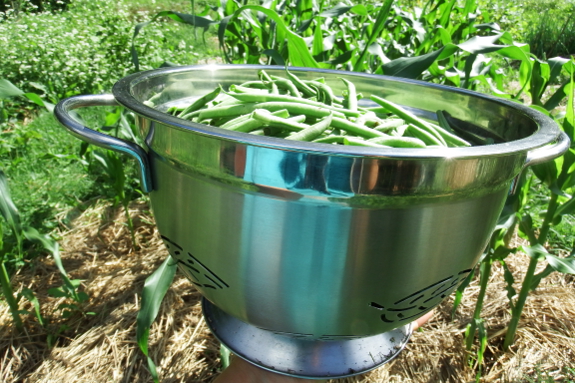
The other good news on
the manure front is that most of our garden soil is now so good that
we're moving out of the renovation stage and into the maintenance stage,
meaning that some crops don't need pre-planting doses of manure at all.
We no longer feed our beans or peas, and in certain beds I also skip
feeding before planting leafy greens. I'm actually starting to imagine a
time when the composted manure from two goats, a flock of layers and an
annual round of broilers, plus the contributions of our composting
toilet will provide more fertility than our farm needs. What a change
from the eroded soil that required truckloads of manure before anything
would grow at all!
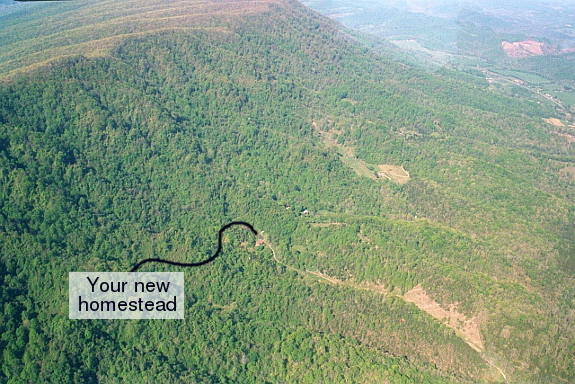
Do you want a beautiful, isolated homestead with the world's best
neighbors? Two friends of mine --- Steve and Maxine --- are selling 90
acres and a house for $225,000. If that's too much for you to handle,
they're also willing to split the land apart into two parcels, like so:
- House + 5.4 acres --- $123,000 (Includes fields, woods, pond, spring and fenced yard)
- 85 forested acres --- $102,000 (Heavily forested land above house to top of Clinch Mountain)
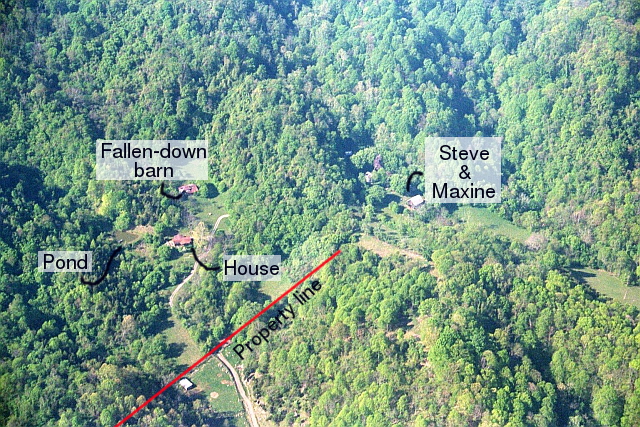
This property belonged to Maxine's mother and is a quarter of a mile from Steve and Maxine's beautiful homestead.
Having neighbors who've homesteaded for as long as I've been alive is
an invaluable resource that should really be factored into the already
low price tag. And even though I can't promise they'll teach you
everything they know, I have a feeling the couple would quickly take
anyone with an interest in farming under their wings. (They're some of
the nicest people I know, are very interested in folks of all shapes,
colors, and creeds, and are much less introverted than I am.)
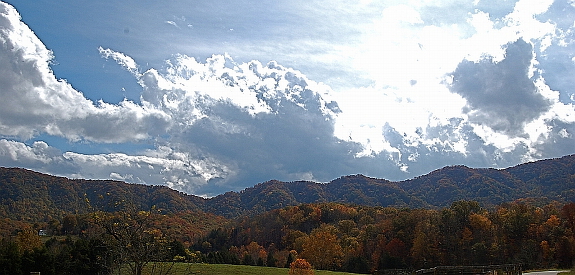
The location is on the Clinch Mountain in Snowflake, Scott County,
Virginia, a ten or fifteen minute drive from Gate City and less than
half an hour from Kingsport (one of the towns we consider "the big
city"). If you're planning on working in the area, chances are you'll be
looking in Kingsport or Johnson City, and these towns are also good
spots for shopping and entertainment.
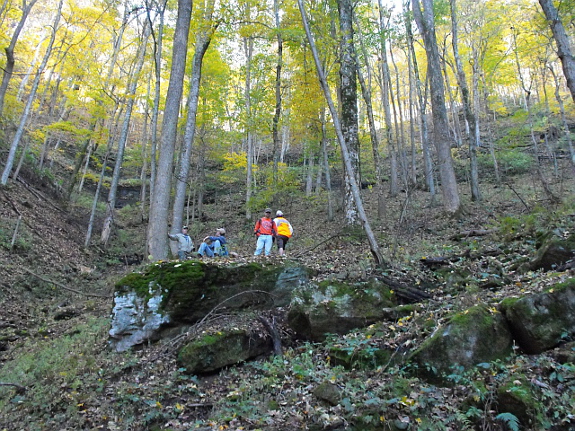
Land features:
- Land extends to the top of the Clinch Mountain
- Pristine forest with old-growth trees, abundant birds and
wildlife, rare and endangered plant species. (Editorial note from me:
This is a truly beautiful forest! Very steep, though, so you'll be in
good shape if you go walking.)
- Conservation easement on forested acres – protecting forest, mountain springs & reservoir (water supply for the house). This covers Steve and Maxine's property as well, so you won't suddenly be next door to a subdivision or a clearcut no matter how the land changes hands. The easement agreement is available upon request.
- Three mown fields totaling about 1 acre in combined size – could be grazed or converted to garden space
- Pond & dock
- Private road
- Fenced yard w/electric gate
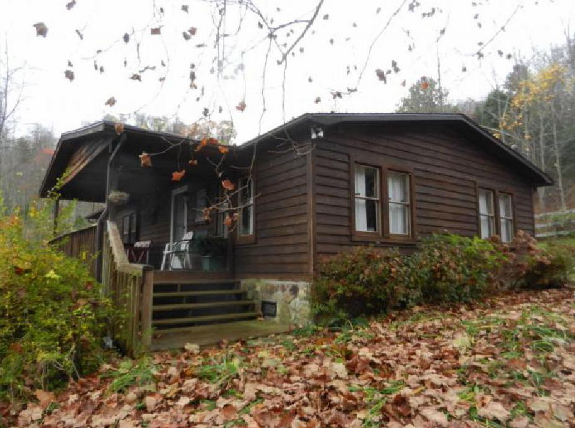
House features:
- 6 rooms, 2 bedrooms, 2 baths (1,164 sq. ft.)
- Custom-built manufactured home (standard building materials)
- Contractor-built large front porch and one-car garage
- Red cedar siding
- Hand-laid field stone over permanent block foundation
- 30/yr shingles on roof (reroofed about 10 years ago)
- 10” fiberglass insulation overhead; 4” fiberglass in walls and under floors
- Heat Pump – relatively new Carrier w/digital thermostat
- Windows – double glazed w/tilt-in feature for cleaning
- Handicap assessable 36” doorways
- Vaulted ceilings w/ceiling fans
- Sheetrock walls/ceilings throughout
- Hardwood floors in living room, dining room, hall and closets
- High-end major appliances – stack washer/dryer, glass-top stove, large refrigerator
- Tiled kitchen counter; oak cabinets
- Bathroom #1 - Tiled floor w/ large tile and glass walk-in shower
- Bathroom #2 – bathtub and stall shower
- Porcelain sinks & commodes in bathrooms
- High-speed internet access
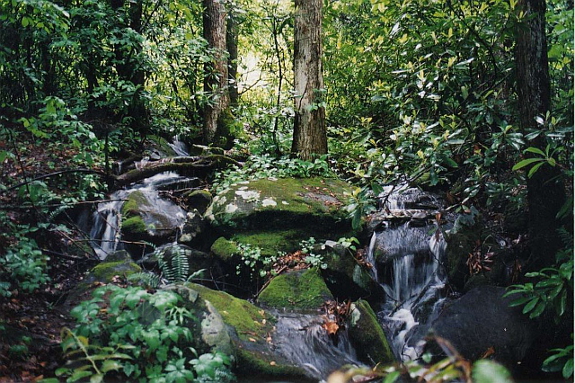
At only $1,200 per acre for the non-house portion, this property is a great deal (and if you get the house, it's move-in ready). So if you're looking for an inexpensive homestead in an area that I consider one of the most beautiful in the world, this might just be it!
We got the lumber needed for
wood shed 2.0 staged today.
Having trouble finding
roofing tin in our local area for some unknown reason.
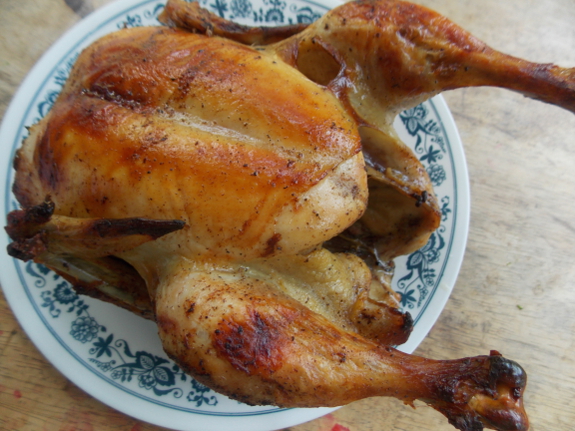
It sounds like you and I
are on the same wavelength, Deb. Mark and I weren't very impressed with
the Cornish Cross we raised last year. Yes, they were economical, but they barely foraged and I felt their meat was only slightly superior to store-bought.
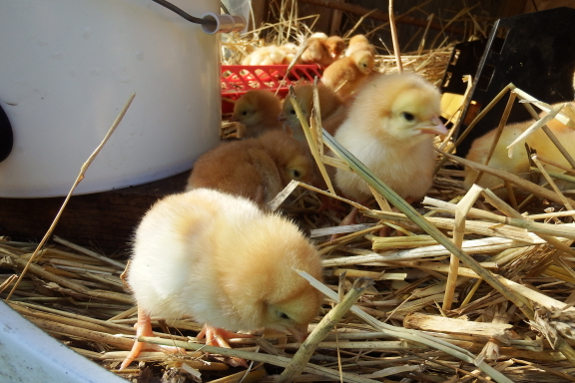
We've raised Australorps as broilers in the past
and felt like their meat was extremely nutritious. But dogs and ducks
and other problems meant we didn't have a large enough flock to hatch
our own eggs this year. And when I pondered the hatchery catalog, I
decided that if I was buying broilers, I might as well try something
that would be a bit meatier and (hopefully) more economical. So, like
you, we chose Red Rangers, which we reserved in midsummer for a fall
broiler run.
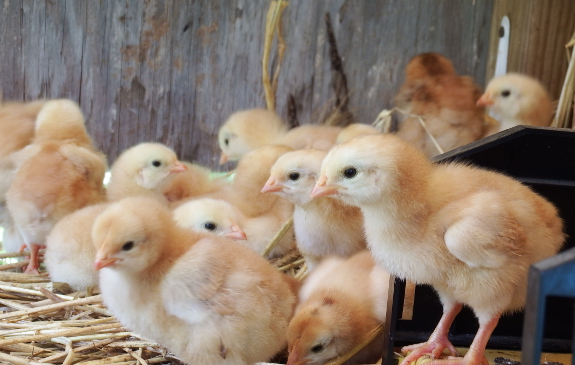
The previous photo showed
the chicks the day we brought them home from the post office --- they
already looked pretty big and spunky! But the comparison to the photo
above, taken two days later, shows that the baby broilers are also
growing fast. I plan to let them out on pasture this weekend and will
keep you posted on how they fare.
The goats have been bad again.
Somehow they figured out how
to pull down a hay bale and use it to jump up to the remaining pile of
bales.
Maybe this tarp will keep
them out?
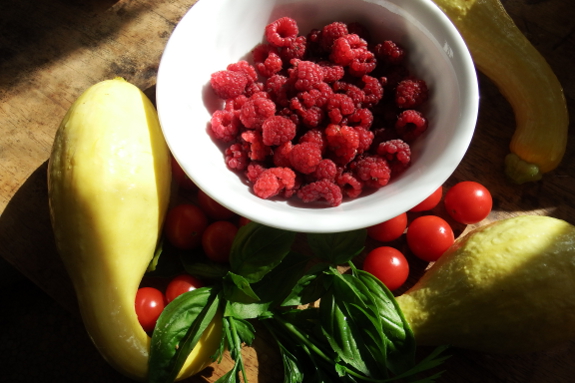
The mercury dropped to 49
this past week, scaring me into thinking fall may be coming along a
little faster than usual. Time to double down on preserving basil (the
tenderest summer crop) and time to make sure the bees are ready for the
winter.
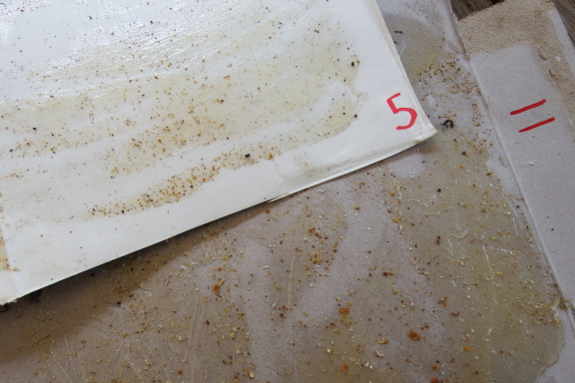
I'll delve into the hives to check on winter stores next week, but for now I started with a varroa mite test.
I expected the news here to be good since splitting and swarming both
lower mite populations dramatically. So I wasn't entirely surprised to
find only 5 mites beneath the daughter hive and 11 beneath the mother
hive after 48 hours. Looks like our high-class bees came through for us
again! (Now, if they'd just make some honey....)
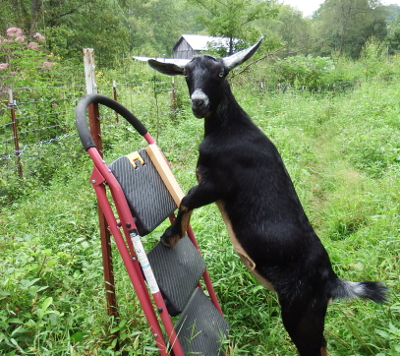 The
rallying cry among those of us who ascribe to voluntary simplicity is
"Things don't make us happy." Why, then, are materialistic habits so
hard to break?
The
rallying cry among those of us who ascribe to voluntary simplicity is
"Things don't make us happy." Why, then, are materialistic habits so
hard to break?
In The How of Happiness, Sonja Lyubomirsky both challenges and supports that rallying cry. She explains that money and possessions do
make us happier...for a little while. If you by a brand new car or
whatever else you've been craving, then your happiness levels receive an
immediate boost. But that boost only lasts for a short period of time,
at which point you tend to drop down to your normal happiness level.
Why? Because humans are
extremely adaptable. Lose a leg, and within a couple of years the
majority of amputees are just as happy as they were pre-surgery. Win the
lottery, and that immediate elation is long gone by the end of twelve
months. Even getting married --- which I've seen in other studies linked
to long-term increases in health and happiness --- is only supposed to
raise you above your own average happiness level for about two years.
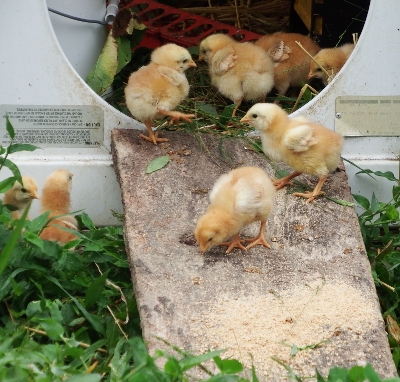 These
examples are all types of hedonistic adaptation --- the human tendency
to get used to both positive and negative changes in our lives. The good
news is, you can counteract hedonistic adaptation, drawing out the
positive effects of everything from that new handbag to that new spouse.
These
examples are all types of hedonistic adaptation --- the human tendency
to get used to both positive and negative changes in our lives. The good
news is, you can counteract hedonistic adaptation, drawing out the
positive effects of everything from that new handbag to that new spouse.
It takes conscious effort
to extend the honeymoon period so you can keep savoring and
appreciating the wonder of having fun-loving goats and cute, cuddly
chicks on your farm, but the project is definitely worth the time.
Similarly, if you've got some money to spend and want to go out and buy
something new to make you happy, try selecting experiences instead of
physical objects, and do so in small doses spread throughout the year
rather than in one big chunk.
Or just be aware of your own tendency toward hedonistic adaptation and
ask yourself --- "how long will that new wardrobe make me happy, and is
that short boost in mood worth the expense?" The awareness just might be
enough to help you achieve your goal of voluntary simplicity.
We got our final set of 9 hay
bales hauled in today.
The Star Plate barn is full
to the brim so these bales will go in the barn.
Want more in-depth information? Browse through our books.
Or explore more posts by date or by subject.
About us: Anna Hess and Mark Hamilton spent over a decade living self-sufficiently in the mountains of Virginia before moving north to start over from scratch in the foothills of Ohio. They've experimented with permaculture, no-till gardening, trailersteading, home-based microbusinesses and much more, writing about their adventures in both blogs and books.
